Kenwood TS-570S User Manual

INSTRUCTION MANUAL
PF |
|
|
|
|
|
|
|
|
|
|
|
|
DSP SLOPE |
|
|
|
|
|
|
HF TRANSCEIVER TS-570D |
|
|
|
|
|
N.R. |
HIGH |
LOW |
|
ATT |
PRE-AMP |
|
|
|
|
|
|
|
|
|
|
B.C. |
UT |
|
|
|
|
|
|
|
|
|
|
|
|
|
|
C |
|
VOX |
PROC |
|
|
|
|
|
|
|
|
|
CW TUNE |
W |
|
|
|
|
|
|
|
|
|
|
|
L |
|
||||
|
|
|
|
|
|
|
|
|
|
|
|
|
O |
|
SEND |
AT TUNE |
|
|
|
|
|
|
|
|
|
FILTER |
|
|
|
|
|
|
|
|
|
|
|
|
|
|
RIT/XIT |
A F |
R F |
|
|
|
|
|
|
|
|
|
UP |
|
|
4 |
6 |
||
|
|
CH1 |
CH2 |
CH3 |
MIC |
LSB |
DOWN |
|
MR |
|
|
|
|
|
PHONES |
|
|
|
|
|
|
|
|
|
|
||||
1 |
2 |
3 |
|
USB |
|
|
|
|
|
|
|
|
||
|
|
|
|
|
|
|
M.IN |
ñ |
+ |
2 |
8 |
|||
|
|
|
|
|
|
|
|
|
|
|
|
|||
|
|
ANT |
REC |
FINE |
PWR |
|
|
|
|
|
|
|
|
|
|
|
CW |
|
|
|
|
|
|
|
|
||||
|
|
4 |
5 |
6 |
|
|
|
|
|
|
|
|
||
|
|
|
FSK |
SPLIT |
TF-SET |
A/B |
RIT |
|
|
0 |
10 |
|||
MIC |
|
|
|
|
|
CH |
IF SHIFT |
SQL |
||||||
NB |
AGC/TONE REV |
KEY |
|
|
|
|
|
|||||||
|
|
7 |
8 |
9 |
FM |
|
|
|
|
|
|
4 |
6 |
|
|
|
|
|
|
|
|
|
|
|
|
||||
|
|
|
AM |
M/V |
A=B |
CLEAR |
XIT |
|
|
|
|
|||
|
|
|
|
|
|
|
|
|
|
|
||||
|
|
|
F.LOCK |
|
DELAY |
MENU 1MHz |
|
|
|
|
|
|
2 |
8 |
|
|
CLR |
0 |
ENT |
|
|
SCAN |
M>VFO |
M.IN |
|
|
|
|
|
|
|
|
|
|
|
|
|
|
|
|
|
|
0 |
10 |
Intelligent Digital Enhanced Communications System
ALL MODE MULTI-BANDER
TS-570S
HF TRANSCEIVER
TS-570D
KENWOOD CORPORATION
© B62-1542-00 (K,E,M)(MC)
09 08 07 06 05 04 03 02 01 00
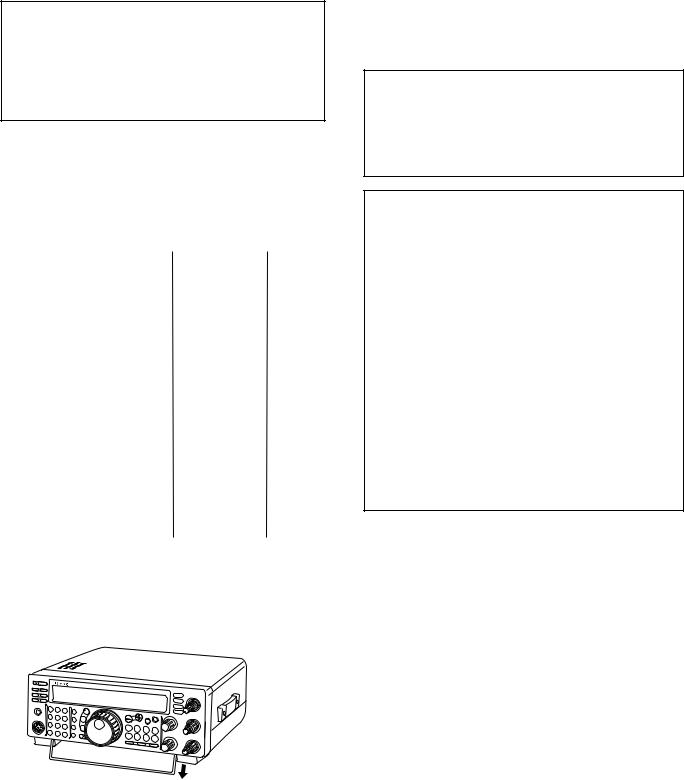
APPLICABLE MODEL
This manual applies to the following model:
TS-570S: All mode multi-bander
TS-570D: HF Transceiver
Intelligent Digital Enhanced Communications System
SUPPLIED ACCESSORIES
Carefully unpack the transceiver. We recommend that you identify the items listed in the table below. In addition, it is safe to keep the box and the packing material. You may need to repack the transceiver in the future.
Accessory |
Part Number |
Quantity |
|
|
|
|
|
Microphone |
T91-0352-XX |
1 |
|
|
|
|
|
DC power cable |
E30-3157-XX |
1 |
|
|
|
|
|
7-pin DIN plug |
E07-0751-XX |
1 |
|
13-pin DIN plug |
E07-1351-XX |
1 |
|
|
|
|
|
Fuse (25 A) |
F05-2531-XX |
1 |
|
Fuse (4 A) |
F06-4027-XX |
1 |
|
Instruction manual |
B62-1542-XX |
1 |
|
|
|
|
|
Schematic/block diagrams1 |
— |
1 |
|
(U.S.A. and Canada only) |
|||
|
|
||
|
|
|
|
Warranty card |
|
|
|
(U.S.A., Canada, and |
— |
1 |
|
Europe only) |
|
|
|
|
|
|
1For other markets, schematic and block diagrams are available as options.
This transceiver is equipped with a bail on the bottom so that you can angle the transceiver. Pull the bail forward to the limit as shown:
NOTICE TO THE USER
One or more of the following statements may be applicable to this equipment.
FCC WARNING
This equipment generates or uses radio frequency energy.
Changes or modifications to this equipment may cause harmful interference unless the modifications are expressly approved in the instruction manual. The user could lose the authority to operate this equipment if an unauthorized change or modification is made.
INFORMATION TO THE DIGITAL DEVICE USER REQUIRED BY THE FCC
This equipment has been tested and found to comply with the limits for a Class B digital device, pursuant to Part 15 of the FCC Rules. These limits are designed to provide reasonable protection against harmful interference in a residential installation.
This equipment generates, uses and can generate radio frequency energy and, if not installed and used in accordance with the instructions, may cause harmful interference to radio communications. However, there is no guarantee that the interference will not occur in a particular installation. If this equipment does cause harmful interference to radio or television reception, which can be determined by turning the equipment off and on, the user is encouraged to try to correct the interference by one or more of the following measures:
•Reorient or relocate the receiving antenna.
•Increase the separation between the equipment and receiver.
•Connect the equipment to an outlet on a circuit different from that to which the receiver is connected.
•Consult the dealer for technical assistance.
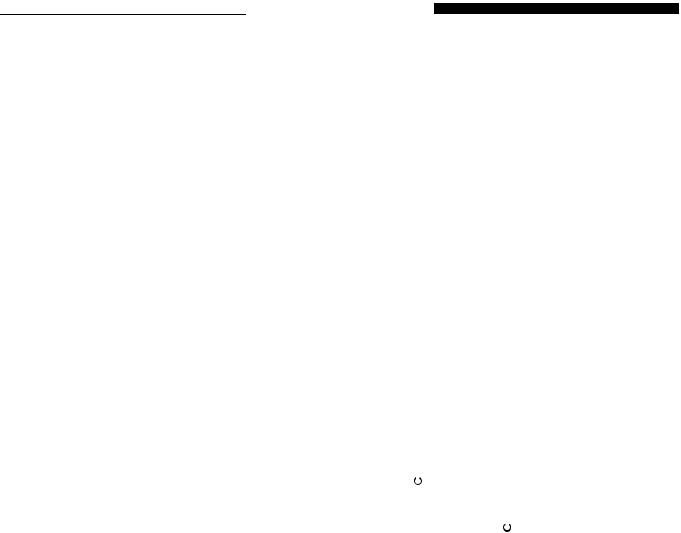
 THANK YOU
THANK YOU 
Thank you for choosing the KENWOOD TS-570 series. This Intelligent Digital Enhanced Communications System was developed by a team of engineers determined to continue the tradition of excellence and innovation in KENWOOD HF transceivers.
This transceiver includes a 16-bit Digital Signal Processing (DSP) unit to process audio frequencies. By taking maximum advantage of DSP technology the transceiver gives you enhanced interference reduction capabilities and improves the quality of audio that you transmit. You will find the differences when you fight QRM and QRN in the new solar cycle. As you learn how to use this transceiver, you also will find KENWOOD is pursuing ìuser friendlinessî. For example, each time you change the Menu No. in Menu mode, you will see, on the display, scrolling messages that tell what you are selecting.
Though user friendly, this transceiver is technically sophisticated and some features may be new to you. Consider this manual to be a personal tutorial from the designers. Allow the manual to guide you through the learning process now, then act as a reference in the coming years.
FEATURES
Taking full advantage of DSP technology, this transceiver
ïProvides high performance receive filters.
ïEnhances the Beat Cancel and Noise Reduction tools.
ïAllows total customization of transmitted audio through the use of functions such as the Transmit Equalizer.
ïEnables Automatic Zero-beating for CW operation. To pursue user friendliness, this transceiver
WRITING CONVENTIONS FOLLOWED
The writing conventions described below have been followed to simplify instructions and avoid unnecessary repetition. This format is less confusing for the reader. Reviewing the following information now will reduce your learning period. That means less time will be spent reading this manual; more time will be available for operating.
Furthermore, a system of advisories is used as follows: WARNING! Possibility of personal injury CAUTION: Possibility of equipment damage Note: Important information or operating tip
Instruction |
|
|
What to Do |
||
|
|
|
|
|
|
Press [KEY]. |
Press and release KEY. |
||||
|
|
|
|
|
|
Press |
Press and hold KEY1 down, |
||||
[KEY1]+[KEY2]. |
then press KEY2. If there are |
||||
|
|
|
more than two keys, press and |
||
|
|
|
hold down each key in turn |
||
|
|
|
until the final key has been |
||
|
|
|
pressed. |
||
|
|
|
|
|
|
Press |
Press KEY1 momentarily, |
||||
[KEY1], [KEY2]. |
release KEY1, then press |
||||
|
|
|
KEY2. |
||
Press |
With the transceiver power |
||||
[KEY]+[ |
|
]. |
OFF, press and hold KEY, |
||
|
|||||
|
|||||
|
|
|
then switch ON the transceiver |
||
|
|
|
power by pressing the |
||
|
|
|
[ |
|
] (POWER) switch. |
|
|
|
|
||
|
|
|
|
||
|
|
|
|
|
|
Note: Basic procedures are numbered sequentially to guide you step-by-step. Additional information pertaining to a step, but not essential to complete the procedure, is provided in bulleted form following many steps.
ïWhen in Menu mode, scrolls messages to tell you what you are selecting.
ïAllows you to quickly and easily save the current transceiver settings in Quick memory.
ïIs equipped with a large, easy to read LCD display.
i
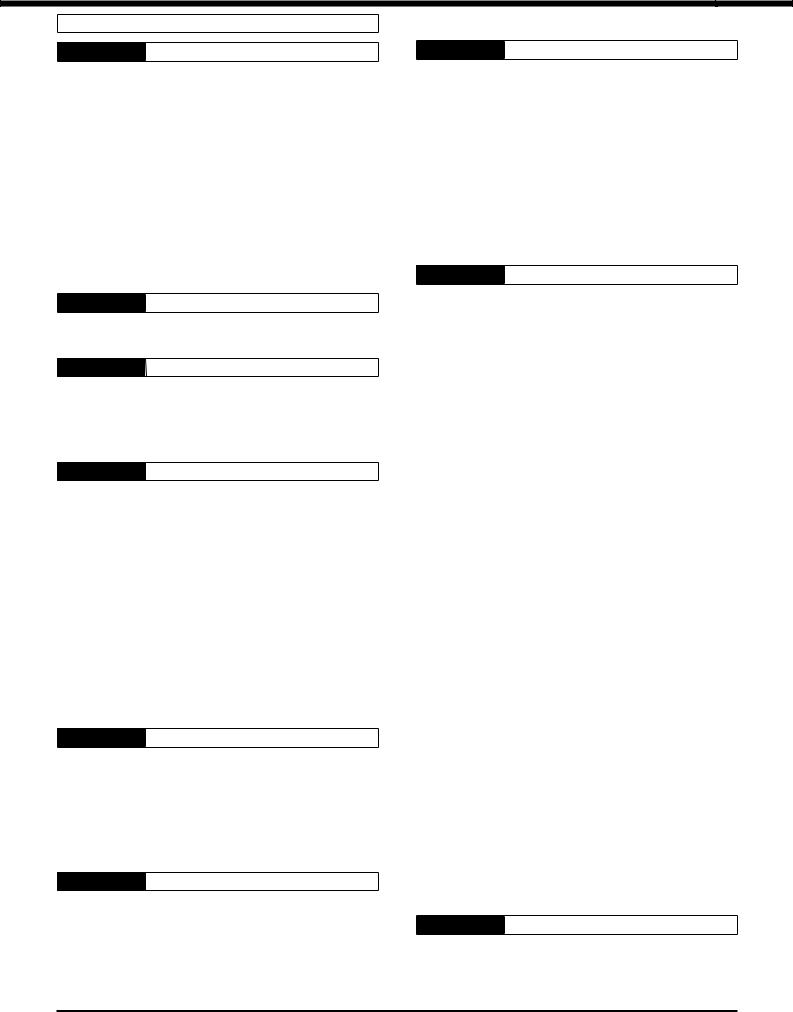
CONTENTS
PRECAUTIONS |
|
IV |
CHAPTER 1 |
INSTALLATION |
1 |
ANTENNA CONNECTION ....................................... |
1 |
|
GROUND CONNECTION ........................................ |
2 |
|
LIGHTNING PROTECTION ..................................... |
2 |
|
DC POWER SUPPLY CONNECTION...................... |
2 |
|
REPLACING FUSES ........................................... |
2 |
|
ACCESSORY CONNECTIONS ............................... |
3 |
|
FRONT PANEL.................................................... |
3 |
|
Headphones (PHONES) ................................. |
3 |
|
Microphone (MIC) ........................................... |
3 |
|
REAR PANEL ...................................................... |
3 |
|
External Speaker (EXT SP) ............................ |
3 |
|
Keys and Keyboards for |
|
|
CW Operation (PADDLE and KEY) ................. |
3 |
|
CHAPTER 2 |
YOUR FIRST QSO |
4 |
RECEIVING ............................................................. |
|
4 |
TRANSMITTING ...................................................... |
5 |
|
CHAPTER 3 |
GETTING ACQUAINTED |
6 |
FRONT PANEL ........................................................ |
6 |
|
MICROPHONE ........................................................ |
9 |
|
REAR PANEL |
........................................................ |
10 |
DISPLAY ............................................................... |
|
11 |
CHAPTER 4 |
OPERATING BASICS |
13 |
SWITCHING POWER ON/OFF ............................. |
13 |
|
ADJUSTING VOLUME .......................................... |
13 |
|
AUDIO FREQUENCY (AF) GAIN....................... |
13 |
|
RADIO FREQUENCY (RF) GAIN ...................... |
13 |
|
SELECTING VFO A OR VFO B ............................. |
13 |
|
SELECTING A BAND ............................................ |
13 |
|
SELECTING A MODE ........................................... |
14 |
|
ADJUSTING SQUELCH ........................................ |
14 |
|
SELECTING A FREQUENCY ................................ |
14 |
|
FRONT PANEL METER ........................................ |
14 |
|
TRANSMITTING .................................................... |
15 |
|
SELECTING TRANSMIT POWER ..................... |
15 |
|
MICROPHONE GAIN ........................................ |
15 |
|
CHAPTER 5 |
MENU SETUP |
16 |
WHAT IS A MENU? ............................................... |
16 |
|
MENU A/ MENU B ................................................. |
16 |
|
MENU ACCESS .................................................... |
16 |
|
MENU CONFIGURATION ..................................... |
17 |
|
CROSS REFERENCE FOR |
|
|
MENU FUNCTIONS .............................................. |
19 |
|
CHAPTER 6 |
BASIC COMMUNICATING |
20 |
SSB TRANSMISSION ........................................... |
20 |
|
CW TRANSMISSION ............................................ |
21 |
|
AUTO ZERO-BEAT ........................................... |
21 |
|
TX SIDETONE/ RX PITCH FREQUENCY ......... |
21 |
|
FM TRANSMISSION ............................................. |
22 |
|
TX DEVIATION SELECTION ............................. |
22 |
|
AM TRANSMISSION ............................................. |
22 |
|
CHAPTER 7 |
SPECIALIZED COMMUNICATING |
23 |
SPLIT-FREQUENCY OPERATION ........................ |
23 |
|
TF-SET (TRANSMIT FREQUENCY SET) .......... |
23 |
|
FM REPEATER OPERATION ................................ |
24 |
|
SELECTING SUBTONE FREQUENCY ............. |
25 |
|
CONTINUOUS OR BURST SUBTONES? ......... |
25 |
|
FM CTCSS OPERATION ....................................... |
25 |
|
DIGITAL OPERATION ........................................... |
26 |
|
RTTY (FREQUENCY SHIFT KEYING) .............. |
26 |
|
AMTOR/ PACKET/ PACTOR/ G-TORTM/ CLOVER. 27 |
||
SLOW SCAN TV/ FACSIMILE ............................... |
28 |
|
SATELLITE OPERATION ...................................... |
28 |
|
CHAPTER 8 |
COMMUNICATING AIDS |
29 |
RECEIVING |
........................................................... |
29 |
SELECTING ....................YOUR FREQUENCY |
29 |
|
Direct Frequency .................................Entry |
29 |
|
Using 1 .......................................MHz Steps |
29 |
|
Quick Changes ............................................. |
29 |
|
Fine Tuning ................................................... |
29 |
|
Equalizing ..............VFO Frequencies (A=B) |
30 |
|
RIT (RECEIVE .........INCREMENTAL TUNING) |
30 |
|
AGC (AUTOMATIC ...............GAIN CONTROL) |
30 |
|
RX EQUALIZER ................................................ |
30 |
|
TRANSMITTING .................................................... |
31 |
|
VOX (VOICE .............-OPERATED TRANSMIT) |
31 |
|
Microphone .................................Input Level |
31 |
|
Delay Time ................................................... |
31 |
|
SPEECH ....................................PROCESSOR |
32 |
|
XIT (TRANSMIT .......INCREMENTAL TUNING) |
32 |
|
CUSTOMIZING TRANSMIT SIGNAL |
|
|
CHARACTERISTICS ......................................... |
33 |
|
Changing Transmit |
|
|
Bandwidth ....................................(SSB/AM) |
33 |
|
Equalizing ......Transmit Audio (SSB/FM/AM) |
33 |
|
MONITORING .........TRANSMITTED SIGNALS |
33 |
|
TRANSMIT ...........................................INHIBIT |
33 |
|
CHANGING FREQUENCY WHILE |
|
|
TRANSMITTING ................................................ |
33 |
|
CW BREAK- .......................................................IN |
34 |
|
USING SEMI BREAK-IN OR |
|
|
FULL BREAK ................................................-IN |
34 |
|
ELECTRONIC ..........................................KEYER |
34 |
|
CHANGING ............................KEYING SPEED |
34 |
|
AUTO WEIGHTING ........................................... |
34 |
|
Reversible ............................Auto Weighting |
34 |
|
CHANGING ........................LOCKED-WEIGHT |
35 |
|
BUG KEY .......................................FUNCTION |
35 |
|
CW MESSAGE .................................MEMORY |
35 |
|
Storing ..................................CW Messages |
35 |
|
Checking CW Messages without Transmitting35 |
||
Transmitting ..........................CW Messages |
35 |
|
CHAPTER 9 |
REJECTING INTERFERENCE |
36 |
IF FILTER .............................................................. |
|
36 |
CHANGING ................IF FILTER BANDWIDTH |
36 |
|
IF SHIFT ............................................................ |
|
36 |
NOISE BLANKER .................................................. |
36 |
|
ii
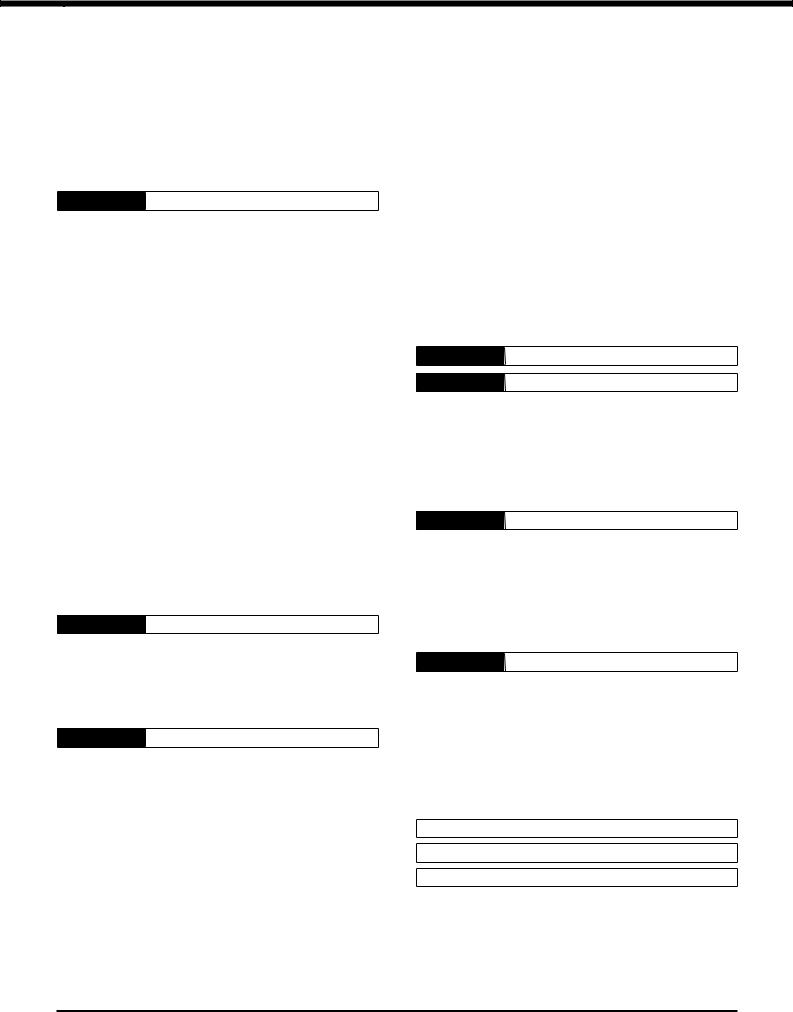
ATTENUATOR ....................................................... |
37 |
|
PREAMPLIFIER .................................................... |
37 |
|
DSP TOOLS |
.......................................................... |
37 |
CHANGING ................RECEIVE BANDWIDTH |
37 |
|
SSB/ FM/ ....................................AM Modes |
37 |
|
CW/ FSK ...........................................Modes |
38 |
|
BEAT CANCEL .................................................. |
38 |
|
NOISE REDUCTION ......................................... |
38 |
|
Changing .........................NR1 Performance |
38 |
|
Setting ...........................NR2 Time Constant |
38 |
|
CHAPTER 10 |
MEMORY FEATURES |
39 |
MICROPROCESSOR ............MEMORY BACKUP |
39 |
|
CONVENTIONAL ..................................MEMORY |
39 |
|
STORING ...........................DATA IN MEMORY |
39 |
|
Simplex .........................................Channels |
39 |
|
Split-Frequency .............................Channels |
40 |
|
MEMORY ....................RECALL AND SCROLL |
40 |
|
Memory ..............................................Recall |
40 |
|
Memory ...............................................Scroll |
41 |
|
Temporary ....................Frequency Changes |
41 |
|
Memory ........................-VFO Split Operation |
41 |
|
MEMORY ......................................TRANSFER |
42 |
|
Memory .............................VFO Transfer |
42 |
|
Channel .......................Channel Transfer |
42 |
|
STORING ...................FREQUENCY RANGES |
43 |
|
Confirming ................Start/End Frequencies |
43 |
|
Programmable ......................................VFO |
43 |
|
ERASING .....................MEMORY CHANNELS |
43 |
|
Full Reset ..................................................... |
43 |
|
Memory .............................Channel Lockout |
44 |
|
QUICK MEMORY .................................................. |
44 |
|
STORING ....................INTO QUICK MEMORY |
44 |
|
RECALLING .........................QUICK MEMORY |
45 |
|
TEMPORARY ..........FREQUENCY CHANGES |
45 |
|
QUICK MEMORY ..............VFO TRANSFER |
45 |
|
CHAPTER 11 |
SCAN |
46 |
PROGRAM SCAN ................................................. |
46 |
|
SCAN HOLD ..................................................... |
46 |
|
MEMORY SCAN ................................................... |
47 |
|
ALL-CHANNEL .......................................SCAN |
47 |
|
GROUP SCAN .................................................. |
47 |
|
CHAPTER 12 |
OPERATOR CONVENIENCES |
48 |
MICROPROCESSOR ...............................RESET |
48 |
|
INITIAL SETTINGS............................................ |
48 |
|
PARTIAL RESET ............................................... |
48 |
|
FULL RESET ..................................................... |
48 |
|
SWITCHING ....................................ANT 1/ ANT 2 |
48 |
|
FREQUENCY ..........................LOCK FUNCTION |
48 |
|
BEEP FUNCTION.................................................. |
49 |
|
DISPLAY DIMMER ................................................ |
49 |
|
PROGRAM FUNCTION .........................BUTTON |
49 |
|
QUICK DATA .....................................TRANSFER |
50 |
|
SETTING .....................................................UP |
50 |
|
Equipment .......................................Needed |
50 |
|
Connections ................................................. |
50 |
|
USING QUICK ...............................TRANSFER |
50 |
|
Transferring Data .......................................... |
50 |
|
Receiving Data ............................................. |
50 |
|
COMPUTER CONTROL ........................................ |
51 |
|
SETTING UP ..................................................... |
51 |
|
Equipment Needed ....................................... |
51 |
|
Connections ................................................. |
51 |
|
COMMUNICATION PARAMETERS ................... |
51 |
|
USING A TRANSVERTER ..................................... |
51 |
|
AUTOMATIC ANTENNA TUNER ........................... |
52 |
|
PRESETTING ................................................... |
52 |
|
DRU-3A DIGITAL RECORDING UNIT |
|
|
(OPTIONAL) .......................................................... |
|
53 |
RECORDING MESSAGES ................................ |
53 |
|
MESSAGE PLAYBACK ..................................... |
53 |
|
Checking Messages ..................................... |
53 |
|
Sending Messages ....................................... |
54 |
|
Changing Inter-message Interval .................. |
54 |
|
Changing Volume ......................................... |
54 |
|
VS-3 VOICE SYNTHESIZER (OPTIONAL) ............ |
55 |
|
CHAPTER 13 |
OPTIONAL ACCESSORIES |
56 |
CHAPTER 14 |
INSTALLING OPTIONS |
57 |
REMOVING THE BOTTOM CASE ........................ |
57 |
|
DRU-3A DIGITAL RECORDING UNIT ................... |
57 |
|
VS-3 VOICE SYNTHESIZER UNIT ........................ |
58 |
|
YK-88C-1/ YK-88CN-1/ YK-88SN-1 FILTERS ........ |
58 |
|
SO-2 TEMPERATURE-COMPENSATED CRYSTAL |
||
OSCILLATOR (TCXO) ........................................... |
59 |
|
CHAPTER 15 CONNECTING PERIPHERAL EQUIPMENT 60 |
||
COMPUTER .......................................................... |
|
60 |
COMPATIBLE TRANSCEIVER .............................. |
60 |
|
RTTY EQUIPMENT ............................................... |
61 |
|
LINEAR AMPLIFIER .............................................. |
61 |
|
ANTENNA TUNER ................................................ |
61 |
|
MCP AND TNC ...................................................... |
62 |
|
CHAPTER 16 |
MAINTENANCE |
63 |
GENERAL INFORMATION .................................... |
63 |
|
SERVICE........................................................... |
|
63 |
SERVICE NOTE ................................................ |
63 |
|
CLEANING |
........................................................ |
63 |
INTERNAL ADJUSTMENTS .................................. |
64 |
|
REFERENCE FREQUENCY CALIBRATION ..... |
64 |
|
ACCESSING THE INTERNAL FUSE ................. |
64 |
|
TROUBLESHOOTING ........................................... |
65 |
|
SPECIFICATIONS |
68 |
|
APPENDIX: COM CONNECTOR PROTOCOL |
70 |
|
INDEX |
|
82 |
iii
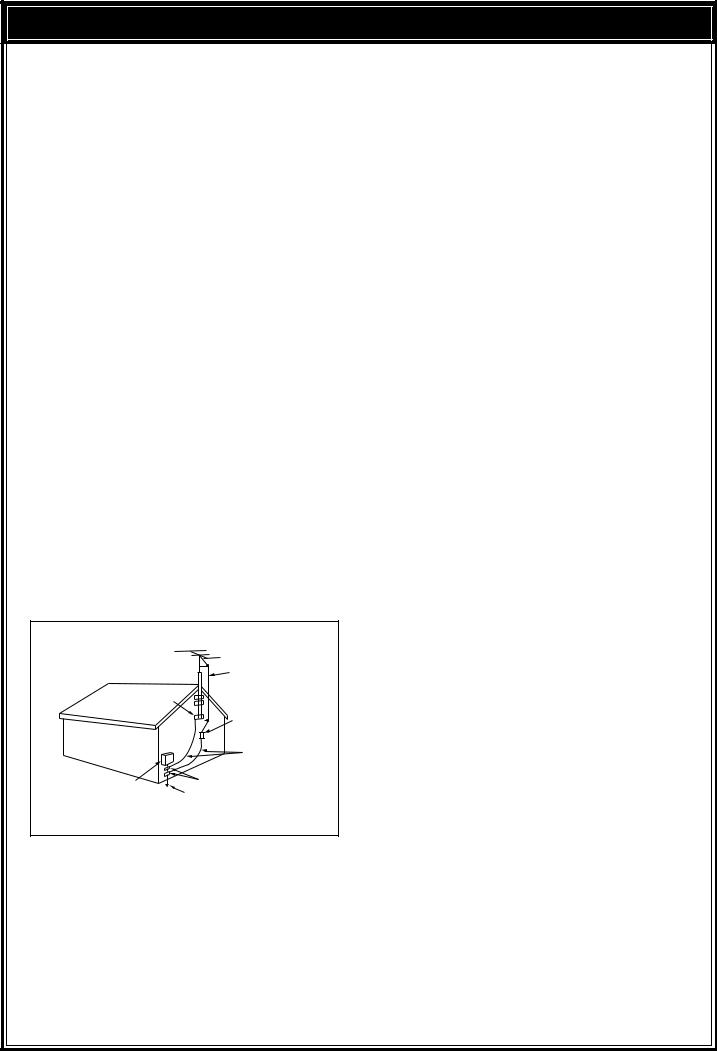
PRECAUTIONS
Please read all safety and operating instructions before using this transceiver. For best results, be aware of all warnings on the transceiver and follow these operating instructions. Retain these safety and operating instructions for future reference.
1Power Source
Connect this transceiver only to the power source described in the operating instructions or as marked on the transceiver itself.
2Power Cable Protection
Route all power cables safely. Ensure the power cables can neither be walked upon nor pinched by items placed near or against the cables. Pay particular attention to locations near AC receptacles, AC outlet strips and points of entry to the transceiver.
3Electrical Shocks
Take care not to drop objects or spill liquids into the transceiver through enclosure openings. Metal objects, such as hairpins or needles, inserted into the transceiver may contact voltages resulting in serious electrical shocks. Never permit children to insert any objects into this transceiver.
4Grounding and Polarization
Do not attempt to defeat methods used for grounding and electrical polarization in the transceiver, particularly involving the input power cable.
5Outdoor Antenna Grounding
Adequately ground all outdoor antennas used with this transceiver using approved methods. Grounding helps protect against voltage surges caused by lightning. It also reduces the chance of a build-up of static charges.
EXAMPLE OF ANTENNA GROUNDING
|
ANTENNA |
|
|
LEAD IN |
|
GROUND |
WIRE |
|
CLAMP |
ANTENNA |
|
|
||
|
DISCHARGE UNIT |
|
|
GROUNDING |
|
|
CONDUCTORS |
|
ELECTRIC SERVICE |
GROUND CLAMPS |
|
POWER SERVICE |
||
EQUIPMENT |
||
|
GROUNDING ELECTRODE |
|
|
SYSTEM |
6Power Lines
Minimum recommended distance for an outdoor antenna from power lines is one and one-half times the vertical height of the associated antenna support structure. This distance allows adequate clearance from the power lines if the support structure should fail for any reason.
7Ventilation
Locate the transceiver so as not to interfere with its ventilation. Do not place books or other equipment on the transceiver that may impede the free movement of air. Allow a minimum of 4 inches (10 cm) between the rear of the transceiver and the wall or operating desk shelf.
8Water and Moisture
Do not use the transceiver near water or sources of moisture. For example, avoid use near bathtubs, sinks, swimming pools, and in damp basements and attics.
9Abnormal Odors
The presence of an unusual odor or smoke is often a sign of trouble. Immediately turn the power OFF and remove the power cable. Contact a dealer or the nearest Service Center for advice.
10Heat
Locate the transceiver away from heat sources such as radiators, stoves, amplifiers or other devices that produce substantial amounts of heat.
11Cleaning
Do not use volatile solvents such as alcohol, paint thinner, gasoline or benzene to clean the cabinet. Use a clean cloth with warm water or a mild detergent.
12Periods of Inactivity
Disconnect the input power cable from the power source when the transceiver is not used for long periods of time.
13Servicing
Remove the transceiverís enclosure only to do accessory installations described by this manual or accessory manuals. Follow provided instructions carefully to avoid electrical shocks. If unfamiliar with this type of work, seek assistance from an experienced individual, or have a professional technician do the task.
14Damage Requiring Service
Enlist the services of qualified personnel in the following cases:
a)The power supply or plug is damaged.
b)Objects have fallen or liquid has spilled into the transceiver.
c)The transceiver has been exposed to rain.
d)The transceiver is operating abnormally or performance has degraded seriously.
e)The transceiver has been dropped or the enclosure damaged.
iv
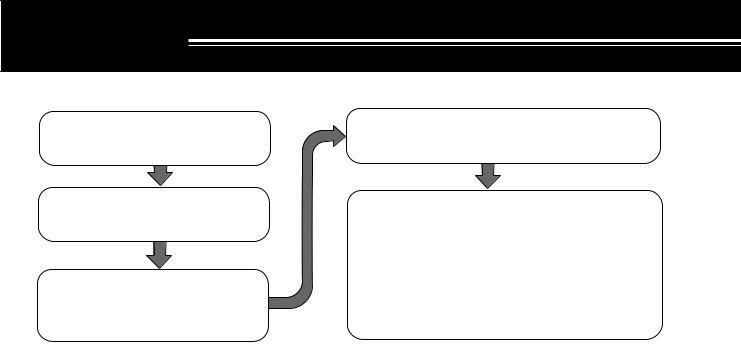
INSTALLATION
|nstall and connect an antenna system {page 1}.
Install a ground system that satisfies DC and RF grounding requirements {page 2}.
Install lightning protection to protect the antenna system, your personal safety, and your property {page 2}.
Install and connect a DC power supply {page 2}.
Connect all accessories to the transceiver {pages 3, 60}. Accessories include the following:
• Microphone |
• Headphones |
||
• |
Antenna Tuner |
• |
External Speaker |
• CW Key |
• RTTY Equipment |
||
• |
Computer |
• |
Linear Amplifier |
•TNC/ Multimode Communications Processor
ANTENNA CONNECTION
The type of the antenna system, consisting of the antenna, ground, and feed line, will greatly affect the successful performance of the transceiver. Use a properly adjusted 50 Ω antenna of good quality to let your transceiver perform at its best. Use a good-quality 50 Ω coaxial cable and a first-quality connector for the connection. Match the impedance of the coaxial cable and antenna so that the SWR is 1.5:1 or less. All connections must be clean and tight.
While the transceiverís protection circuit will activate if the SWR is greater than 2.5:1, do not rely on protection to compensate for a poorly functioning antenna system. High SWR will cause the transmit output to drop, and may lead to radio frequency interference to consumer products such as stereo receivers and televisions. You may even interfere with your own transceiver. Reports that your signal is garbled or distorted, especially at peak modulation, may indicate that your antenna system is not efficiently radiating the transceiverís power. If you feel a tingle from the transceiverís cabinet or the microphoneís metal fittings when you modulate, you can be certain that, at the least, your coax connector is loose at the rear of the radio and, at the worst, your antenna system is not efficiently radiating power.
Connect your antenna feed line to ANT 1. If you are using two antennas, connect the second antenna to
ANT 2.
CAUTION:
TRANSMITTING WITHOUT FIRST CONNECTING AN ANTENNA OR OTHER MATCHED LOAD MAY DAMAGE THE TRANSCEIVER. ALWAYS CONNECT THE ANTENNA TO THE TRANSCEIVER BEFORE TRANSMITTING.
USE A LIGHTNING ARRESTOR TO PREVENT FIRE, ELECTRIC SHOCK, OR DAMAGE TO THE TRANSCEIVER.
APPROX. LOSS (dB) PER 30 METERS (100 FEET) OF CORRECTLY MATCHED 50 Ω LINE
ïUse only as a general guide. Specifications may vary between cable manufacturers.
Transmission Line |
3.5 MHz |
14 MHz |
30 MHz |
|
|
|
|
RG-174, -174A |
2.3 |
4.3 |
6.4 |
|
|
|
|
RG-58A, -58C |
0.75 |
1.6 |
2.6 |
|
|
|
|
3D-2V |
0.80 |
1.5 |
2.3 |
|
|
|
|
RG-58, -58B |
0.65 |
1.5 |
2.3 |
|
|
|
|
RG-58 Foam |
0.70 |
1.4 |
2.1 |
RG-8X |
0.50 |
1.0 |
2.0 |
|
|
|
|
5D-2V |
0.45 |
0.93 |
1.4 |
|
|
|
|
RG-8, -8A, -9, -9A, -9B, |
0.38 |
0.80 |
1.2 |
-213, -214, -215 |
|
|
|
|
|
|
|
5D-FB |
N/A |
0.80 |
1.0 |
|
|
|
|
RG-8 Foam |
0.29 |
0.60 |
0.90 |
|
|
|
|
8D-2V |
0.29 |
0.60 |
0.90 |
|
|
|
|
10D-2V |
0.24 |
0.50 |
0.72 |
|
|
|
|
9913 |
0.24 |
0.48 |
0.70 |
|
|
|
|
8D-FB |
N/A |
0.48 |
0.68 |
|
|
|
|
10D-FB |
N/A |
0.37 |
0.54 |
|
|
|
|
12D-FB |
N/A |
0.33 |
0.45 |
|
|
|
|
RG-17, -17A |
0.13 |
0.29 |
0.48 |
|
|
|
|
1/2" Hardline |
0.12 |
0.26 |
0.40 |
|
|
|
|
20D-2V |
< 0.10 |
0.25 |
0.39 |
3/4" Hardline |
< 0.10 |
0.21 |
0.32 |
7/8" Hardline |
< 0.10 |
0.16 |
0.26 |
N/A: Not available
1
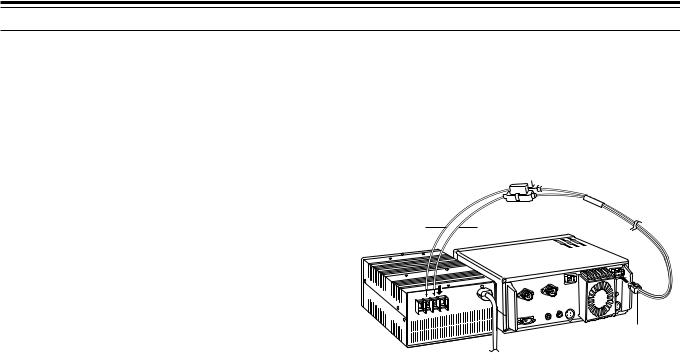
1 INSTALLATION
GROUND CONNECTION
At the minimum, a good DC ground is required to prevent such dangers as electric shock. For superior communications results, a good RF ground is required, against which the antenna system can operate. Both of these conditions can be met by providing a good earth ground for your station. Bury one or more ground rods, or a large copper plate under the ground, and connect this to the transceiver GND terminal. Use heavy gauge wire or a copper strap, cut as short as possible, for this connection. Just as for antenna work, all connections must be clean and tight.
First connect the DC power cable to the regulated DC power supply and check that polarities are correct (Red: positive, Black: negative). Then connect the connectorized end of the DC power cable to the DC 13.8 Vpower connector on the transceiver rear panel. Press the DC power cable connector firmly into the connector on the transceiver until the locking tab clicks.
 Fuse holders
Fuse holders
Black Red
LIGHTNING PROTECTION
Consider carefully how to protect your equipment and your home from lightning. Even in areas where lightning storms are less common, there are usually a limited number of storms each year. Take the time to study the best way to protect your installation from the effects of lightning by consulting reference material on the subject.
The installation of a lightning arrestor is a start, but there is more that you can do. For example, terminate your antenna system transmission lines at an entry panel that you install outside your home. Ground this entry panel to a good outside ground, and then connect appropriate feed lines between the entry panel and your transceiver. When a lightning storm occurs, you can ensure added protection by disconnecting the feed lines from your transceiver.
CAUTION: DO NOT ATTEMPT TO USE A GAS PIPE (WHICH IS
CLEARLY DANGEROUS), AN ELECTRICAL CONDUIT (WHICH
HAS THE WHOLE HOUSE WIRING ATTACHED AND MAY ACT LIKE AN ANTENNA), OR A PLASTIC WATER PIPE FOR A
GROUND.
DC POWER SUPPLY CONNECTION
In order to use this transceiver, you will need a separate 13.8 V DC power supply that must be purchased separately. DO NOT directly connect the transceiver to an AC outlet! Use the supplied DC power cable to connect the transceiver to a regulated power supply. Do not substitute a cable with smaller gauge wires. The current capacity of your power supply must be 20.5 A peak or more.
CAUTION:
BEFORE CONNECTING THE DC POWER SUPPLY TO THE TRANSCEIVER, BE SURE TO SWITCH THE TRANSCEIVER AND THE DC POWER SUPPLY OFF.
DO NOT PLUG THE DC POWER SUPPLY INTO AN AC OUTLET UNTIL YOU MAKE ALL CONNECTIONS.
TS-570 |
DC 13.8 V |
|
DC power supply
REPLACING FUSES
If the fuse blows, determine the cause then correct the problem. After the problem is resolved, only then replace the fuse. If newly installed fuses continue to blow, disconnect the power plug and contact your dealer or nearest Service Center for assistance.
Fuse Location |
Fuse Current Rating |
|
|
|
|
TS-570 |
4 A |
|
(For an external antenna tuner) |
||
|
||
|
|
|
Supplied Accessory |
25 A |
|
Cable |
||
|
||
|
|
CAUTION: REPLACE BLOWN FUSES ONLY AFTER
INVESTIGATING AND CORRECTING THE CAUSE OF THE FAILED FUSE. ALWAYS REPLACE A BLOWN FUSE BY A NEW
FUSE WITH THE SPECIFIED RATINGS.
2
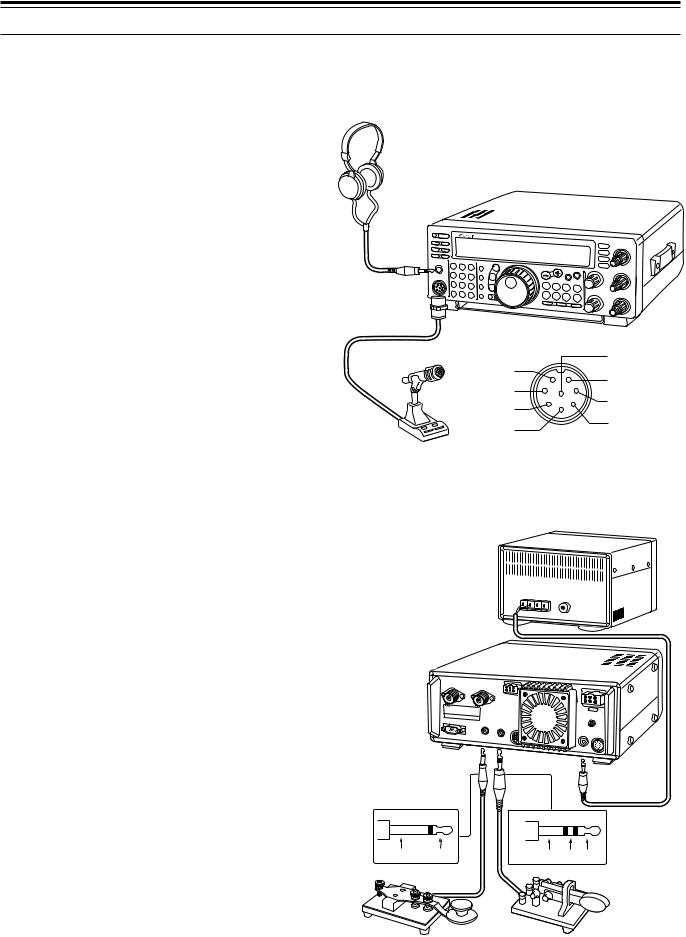
1 INSTALLATION
ACCESSORY CONNECTIONS
FRONT PANEL
■Headphones (PHONES)
Use headphones having 4 to 32 Ω impedance. You can also use stereo headphones. When headphones are used, no sound is heard from the internal (or optional external) speaker. Use a 6.0 mm (1/4") diameter, 2-conductor (mono) or 3-conductor (stereo) plug.
■Microphone (MIC)
To communicate in the voice modes, connect to the MIC connector a microphone having an impedance between 250 Ω and 600 Ω. Insert the connector from your microphone fully, then screw the retaining ring clockwise until snug. Compatible microphones include the MC-43S, MC-47, MC-60A, MC-80, MC-85, and MC-90. Do not use the MC-44, MC-44DM, MC-45, MC-45E, MC-45DM, MC-45DME, MC-52DM, or MC-53DM microphone.
REAR PANEL
■ External Speaker (EXT SP)
Ensure any external speaker used has an impedance of 8 Ω. Use a 3.5 mm (1/8") diameter, 2-conductor (mono) plug. When an external speaker is used, no sound is heard from the internal speaker.
WARNING! DO NOT CONNECT HEADPHONES TO THIS
JACK. THE HIGH AUDIO OUTPUT AT THIS JACK COULD DAMAGE YOUR HEARING.
■Keys and Keyboards for CW Operation (PADDLE and KEY)
For CW operation using the internal electronic keyer, connect a keyer paddle to the PADDLE jack. For CW operation without using the internal electronic keyer, connect a straight key, semi-automatic key (bug), electronic keyer, or the CW keyed output from a Multimode Communications Processor (MCP) to the KEY jack. The jacks mate with a 6.0 mm (1/4") 3-conductor plug and a 3.5 mm (1/8") 2-conductor plug respectively. External electronic keyers or MCPs must use positive keying to be compatible with this transceiver. Use a shielded cable between the key and the transceiver.
Headphones
|
TS-570 |
|
|
|
MICq |
iGND(STBY) |
|
|
uGND(MIC) |
||
|
PTTw |
||
|
yNC |
||
DOWNe |
|||
|
|||
|
UPr |
t8 V(10 mA max) |
|
|
|
||
Microphone |
MIC connector (Front view) |
||
External speaker
TS-570
Note: Due to the full-featured functionality of the internal |
Ground + |
Ground Dash Dot |
electronic keyer, you may decide it’s unnecessary to connect |
||
both a paddle and another type of key unless you specifically |
|
|
want to use a keyboard for CW. It’s recommended that you |
|
|
become familiar with the internal keyer by reading |
|
|
“ELECTRONIC KEYER” {page 34} before making your decision. |
|
|
• |
Straight key |
• Paddle |
• |
Bug |
|
• |
Electronic keyer |
|
• |
MCP CW output |
|
3
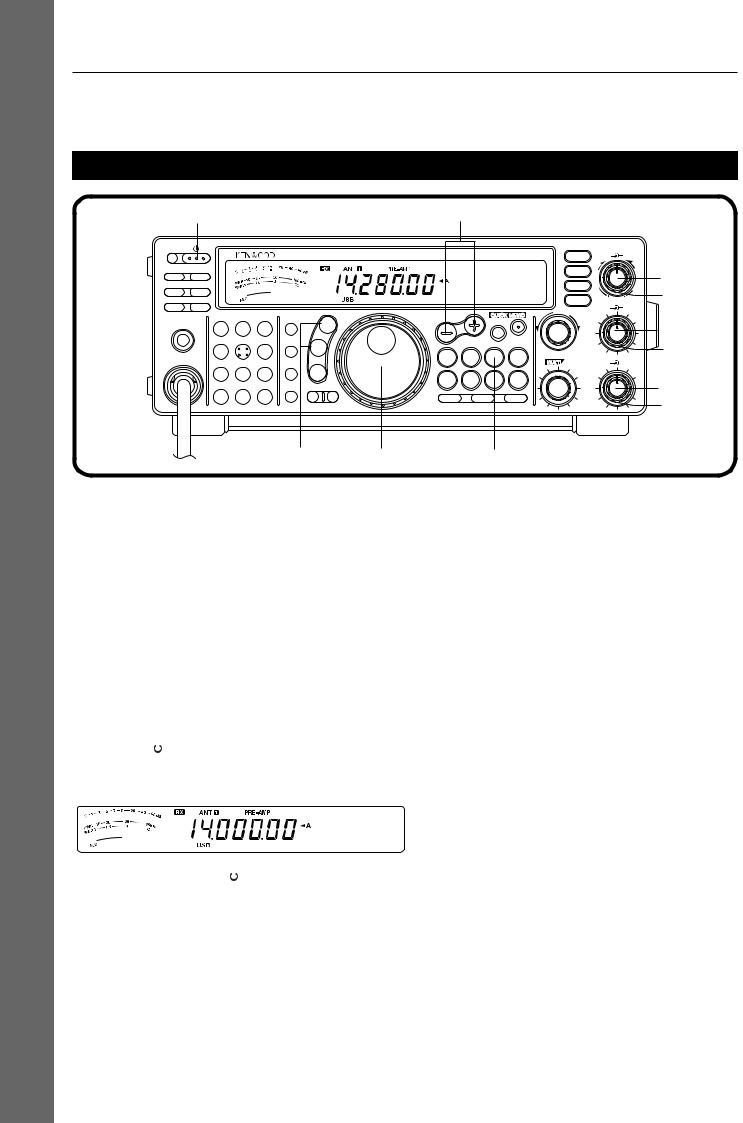
YOUR FIRST QSO
2 YOUR FIRST QSO
Since youíve now installed the TS-570, why not try it? The instructions below are abbreviated. They are intended only to act as a quick introduction. If you encounter problems or thereís something you donít understand, you can read about the subject in more detail later.
RECEIVING
|
w |
|
|
|
|
|
|
PF |
|
|
|
|
|
|
|
|
|
|
|
|
HF TRANSCEIVER TS-570D |
||
ATT |
PRE-AMP |
|
|
|
|
|
|
VOX |
PROC |
|
|
|
|
|
|
SEND |
AT TUNE |
|
|
|
|
|
|
|
|
CH1 |
CH2 |
CH3 |
MIC |
LSB |
|
PHONES |
1 |
2 |
3 |
||||
|
USB |
||||||
|
|
|
|
||||
|
|
ANT |
REC |
FINE |
PWR |
CW |
|
|
|
4 |
5 |
6 |
|||
|
|
|
FSK |
||||
MIC |
NB |
AGC/TONE REV |
KEY |
|
|||
|
|
FM |
|||||
|
|
7 |
8 |
9 |
|
||
|
|
|
AM |
||||
|
|
|
F.LOCK |
|
DELAY |
MENU 1MHz |
|
CLR 0 ENT
y u
Note: Only those buttons and controls required to briefly try the transceiver are explained in this section.
q Set the following as specified:
ï |
AF control: |
Fully counterclockwise |
ï |
RF control: |
Fully clockwise |
ïDSP SLOPE (HIGH) control:
Fully clockwise
ïDSP SLOPE (LOW) control:
Fully counterclockwise
ïIF SHIFT control: Center
ï SQL control: |
Fully counterclockwise |
wSwitch ON the DC power supply, then press and hold the [  ] (POWER) switch briefly.
] (POWER) switch briefly.
ïThe transceiver switches ON. Indicators and frequency digits should appear on the display.
t
|
|
DSP SLOPE |
|
|
N.R. |
HIGH |
LOW |
|
B.C. |
O |
q |
|
T |
|
|
|
|
U |
|
|
|
C |
|
|
CW TUNE |
W |
|
|
L |
q |
|
|
FILTER |
|
|
|
RIT/XIT |
AF |
RF |
UP |
4 |
6 |
|
DOWN
|
|
MR |
|
|
|
|
|
qr |
|
|
|
M.IN |
– |
+ |
2 |
8 |
|
|
|
|
|
|
|
|
q |
|
SPLIT |
TF-SET |
A/B |
RIT |
|
|
0 |
10 |
|
CH |
|
IF SHIFT |
SQL |
|
||||
|
|
|
|
|
|
|||
|
|
|
|
|
|
4 |
6 |
|
M/V |
A=B |
CLEAR |
XIT |
|
|
|
|
q |
|
|
|
|
|
|
2 |
8 |
|
SCAN |
M>VFO |
M.IN |
|
|
|
|
q |
|
|
|
|
|
|
|
0 |
10 |
|
e
eVFO A should already be selected for receiving and transmitting, and you should see ìtAî on the display. If not, press the [A/B] button.
rIncrease the AF control slowly clockwise until you hear a suitable level of background noise.
tSelect an Amateur band by pressing the [UP] or [DOWN] button.
ySelect an operating mode by pressing the
[LSB/USB] or [CW/FSK] button.
ïPress the same button again to toggle to the second function on the button. For example, repeatedly pressing the [LSB/USB] button switches between LSB and USB modes.
uTurn the Tuning control to tune in a station.
ïIf no stations are heard but you have an antenna connected, possibly the wrong antenna connector is selected. Pressing the [ANT] button toggles between the Antenna 1 and the Antenna 2 connectors.
ïNote that pressing [  ] (POWER) for more than approximately 2 seconds switches the transceiver power OFF.
] (POWER) for more than approximately 2 seconds switches the transceiver power OFF.
4
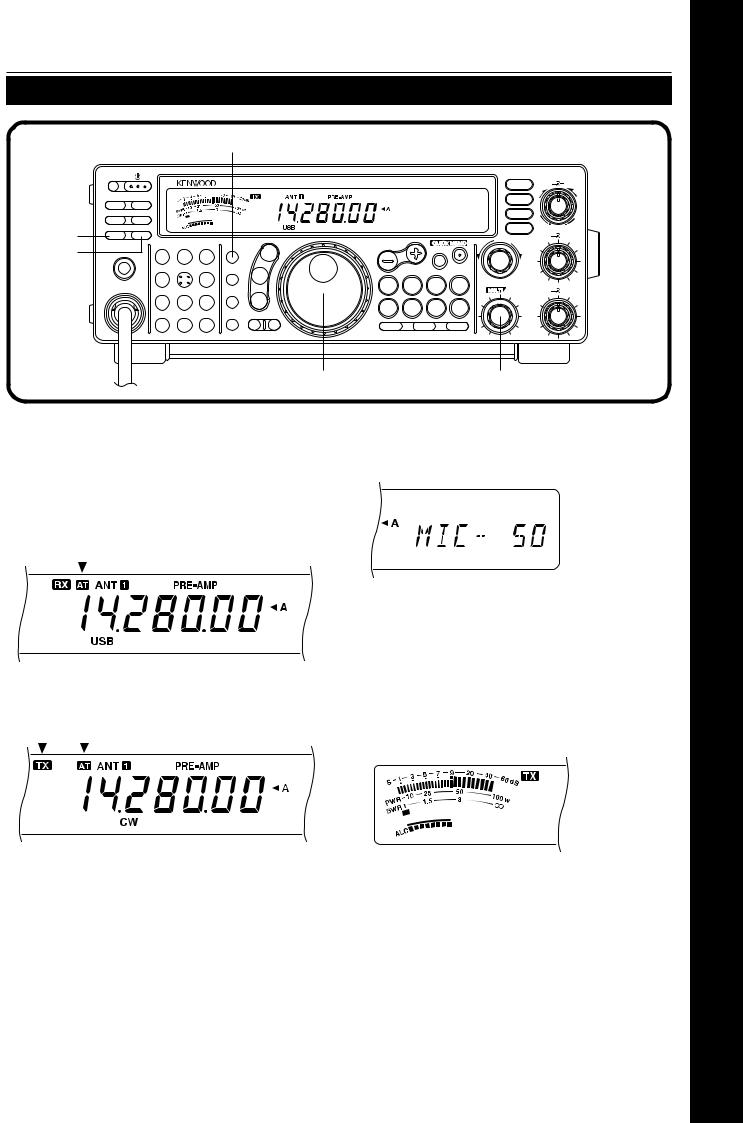
2 YOUR FIRST QSO
TRANSMITTING
ro
|
PF |
|
|
|
|
|
|
|
|
|
|
|
|
|
HF TRANSCEIVER TS-570D |
||
|
ATT |
PRE-AMP |
|
|
|
|
|
|
|
VOX |
PROC |
|
|
|
|
|
|
ti |
SEND |
AT TUNE |
|
|
|
|
|
|
we |
|
|
CH1 |
CH2 |
CH3 |
MIC |
LSB |
|
PHONES |
1 |
2 |
3 |
|||||
|
USB |
|||||||
|
|
|
|
|
||||
|
|
|
ANT |
REC |
FINE |
PWR |
CW |
|
|
|
|
4 |
5 |
6 |
|||
|
|
|
|
FSK |
||||
|
MIC |
NB |
AGC/TONE REV |
KEY |
|
|||
|
|
|
FM |
|||||
|
|
|
7 |
8 |
9 |
|
||
|
|
|
|
AM |
||||
|
|
|
|
F.LOCK |
|
DELAY |
MENU 1MHz |
|
CLR 0 ENT
q
After tuning in a few stations as explained in the previous section ìRECEIVINGî, try making a contact.
qAssuming you are already on the correct band with the correct mode selected (steps 1~7 in ìRECEIVINGî), use the Tuning control to tune in a station or to select an unused frequency.
wMomentarily press the [AT TUNE] button. ï ìATî appears.
ePress and hold the [AT TUNE] button to allow the built-in antenna tuner to function.
ï ìATî blinks and ìTXî appears.
|
|
|
|
|
|
DSP SLOPE |
|
|
|
|
|
|
N.R. |
HIGH |
LOW |
|
|
|
|
|
B.C. |
T |
|
|
|
|
|
|
|
U |
|
|
|
|
|
|
|
C |
|
|
|
|
|
|
|
W |
|
|
|
|
|
CW TUNE |
O |
|
|
|
|
|
|
|
|
L |
|
|
|
|
|
FILTER |
|
|
|
|
|
|
|
RIT/XIT |
AF |
RF |
|
|
UP |
|
|
4 |
6 |
||
DOWN |
|
MR |
|
|
|
|
|
|
|
|
|
|
|
|
|
|
|
|
M.IN |
– |
+ |
2 |
8 |
|
|
|
|
|
|||
|
|
|
|
|
|
|
|
|
|
|
|
|
|
0 |
10 |
SPLIT |
TF-SET |
A/B |
RIT |
CH |
IF SHIFT |
SQL |
|
|
|
|
|
||||
|
|
|
|
|
|
4 |
6 |
M/V |
A=B |
CLEAR |
XIT |
|
|
|
|
|
|
|
|
|
|
2 |
8 |
SCAN |
M>VFO |
M.IN |
|
|
|
|
|
|
|
|
|
|
|
0 |
10 |
u
rSSB: Press the [MIC] button to activate the Microphone Gain Setting function.
ï ìMIC-50î appears.
CW: Skip this step.
t Press the [SEND] button.
ïìTXî appears.
yBegin speaking into the microphone or sending CW with your key.
uSSB: While speaking into the microphone, adjust the MULTI/CH control so that the ALC meter reflects according to your voice level.
ïTuning should be completed in less than approximately 20 seconds. ìATî stops blinking and ìTXî disappears.
ïIf tuning is not completed in approximately 20 seconds, error beeps sound. Press [AT TUNE]to stop the error beeps and to quit tuning. Check your antenna system before continuing.
Note: Tuning will automatically turn off after approximately
60 seconds. In addition, “AT” will disappear and the error beeps will stop.
CW: Skip this step.
iPress the [SEND] button again when you want to return to receive mode.
oPress the [MIC] button again to quit the Microphone Gain Setting function.
This completes your introduction to the TS-570, but there is a great deal more to know. ìOPERATING BASICSî {page 13} and following chapters explain all functions of the transceiver starting with the most basic, commonly-used functions.
QSO FIRST YOUR
5
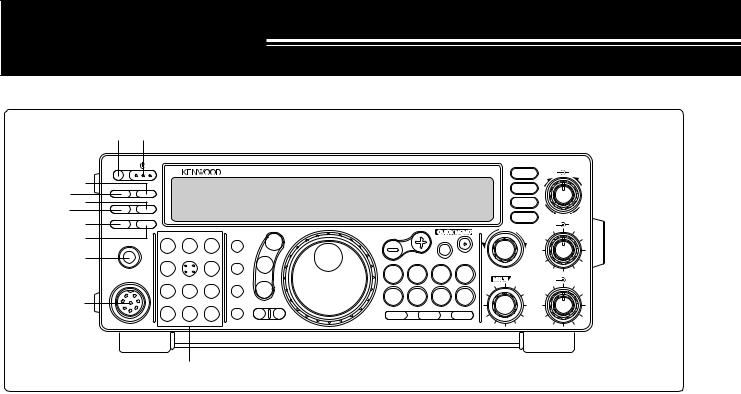
GETTING ACQUAINTED
FRONT PANEL
w q
|
PF |
|
|
|
|
|
|
|
re |
|
|
|
|
|
HF TRANSCEIVER TS-570D |
||
ATT |
PRE-AMP |
|
|
|
|
|
||
yt |
VOX |
PROC |
|
|
|
|
|
|
i |
SEND |
AT TUNE |
|
|
|
|
|
|
|
|
|
|
|
|
|
||
u |
|
|
CH1 |
CH2 |
CH3 |
MIC |
LSB |
|
PHONES |
1 |
2 |
3 |
|||||
|
USB |
|||||||
o |
|
|
|
|
||||
|
|
ANT |
REC |
FINE |
PWR |
CW |
||
|
|
4 |
5 |
6 |
||||
|
|
|
|
FSK |
||||
|
MIC |
NB |
AGC/TONE REV KEY |
|
||||
|
|
|
FM |
|||||
|
|
|
7 |
8 |
9 |
|
||
!0 |
|
|
|
AM |
||||
|
|
|
F.LOCK |
|
DELAY |
MENU 1MHz |
||
CLR 0 ENT
!1
q  (POWER) switch
(POWER) switch
Press and hold down briefly to switch ON the transceiver power. Press again to switch OFF the power {page 13}.
w PF button
A function can be assigned by the user to this Programmable Function button {page 49}. The default function is Voice 1 {page 55}.
e PRE-AMP button
Press to switch ON or OFF the receive preamplifier {page 37}.
r ATT button
Press to switch ON or OFF the receive attenuator {page 37}.
t PROC button
Press to switch ON or OFF the Speech Processor for transmitting {page 32}.
y VOX button
In voice modes, press to switch ON or OFF the VoiceOperated Transmit function {page 31} or, in CW mode, to switch ON or OFF the Break-in function {page 34}.
u AT TUNE button
Use for activating the internal antenna tuner {page 52} or an external antenna tuner.
i SEND button
Press to switch the transceiver between receive mode and transmit mode {page 15}.
|
|
|
|
|
|
|
DSP SLOPE |
|
|
|
|
|
|
N.R. |
|
HIGH |
LOW |
|
|
|
|
|
B.C. |
|
T |
|
|
|
|
|
|
|
|
U |
|
|
|
|
|
|
|
|
C |
|
|
|
|
|
|
|
|
W |
|
|
|
|
|
|
CW TUNE |
O |
|
|
|
|
|
|
|
|
|
L |
|
|
|
|
|
|
FILTER |
|
|
|
|
|
|
|
|
RIT/XIT |
|
AF |
RF |
|
UP |
|
|
|
|
4 |
6 |
|
DOWN |
|
MR |
|
|
|
|
|
|
|
|
|
|
|
|
|
|
|
|
|
|
M.IN |
ñ |
+ |
|
2 |
8 |
|
|
|
|
|
|
|||
|
|
|
|
|
|
|
|
|
|
|
|
|
|
|
|
0 |
10 |
SPLIT |
TF-SET |
A/B |
RIT |
|
CH |
IF SHIFT |
SQL |
|
|
|
|
|
|
||||
|
|
|
|
|
|
|
4 |
6 |
M/V |
A=B |
CLEAR |
XIT |
|
|
|
|
|
|
|
|
|
|
|
|
2 |
8 |
SCAN |
M>VFO |
M.IN |
|
|
|
|
|
|
|
|
|
|
|
|
|
0 |
10 |
o PHONES jack
Connect headphones to this jack. Inserting a plug into the jack automatically mutes the audio from the speaker {page 3}.
!0MIC connector
Connect a compatible microphone, then snugly screw down the connector locking ring {page 3}.
!1Multi-purpose keypad
Consists of 10 buttons that are used for inputting numeric data. Also used for the following functions.
ïCH 1, CH 2, CH 3 buttons
Press to select functions associated with the internal electronic keyer {page 34} and the DRU-3A Digital Recording Unit {page 53} .
ïANT button
Press to select either Antenna 1 or Antenna 2 that are connected to their respective antenna connectors on the rear panel {pages 1, 48}.
ïREC button
Press to select the record mode for CW Message Memory {page 35} or for the optional DRU-3A Digital Recording Unit {page 53}.
ïFINE button
Press to reduce by one-tenth the Tuning control step size to allow more precise tuning {page 29}.
ïNB button
Press to switch ON or OFF the analog Noise Blanker {page 36}.
ïAGC/TONE button
Press to switch the Automatic Gain Control function between Slow and Fast {page 30}. Also switches ON or OFF the Subtone {page 24} or CTCSS function {page 25}.
6
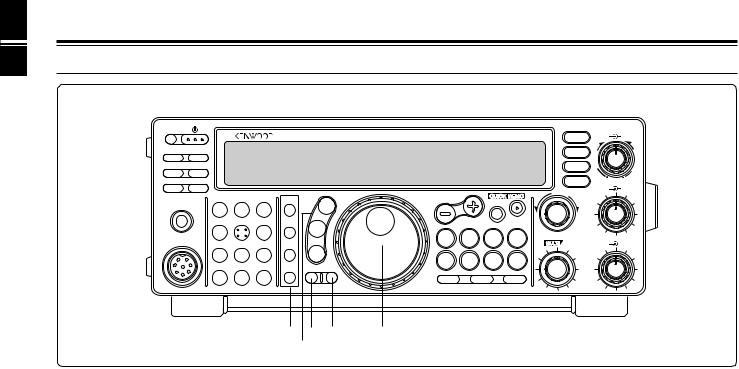
3 GETTING ACQUAINTED
PF |
|
|
|
|
|
|
|
|
|
|
|
|
DSP SLOPE |
|
|
|
|
|
|
HF TRANSCEIVER TS-570D |
|
|
|
|
|
N.R. |
HIGH |
LOW |
|
ATT |
PRE-AMP |
|
|
|
|
|
|
|
|
|
|
B.C. |
T |
|
|
|
|
|
|
|
|
|
|
|
|
|
|
U |
|
|
|
|
|
|
|
|
|
|
|
|
|
|
C |
|
VOX |
PROC |
|
|
|
|
|
|
|
|
|
CW TUNE |
W |
|
|
|
|
|
|
|
|
|
|
|
L |
|
||||
|
|
|
|
|
|
|
|
|
|
|
|
|
O |
|
SEND |
AT TUNE |
|
|
|
|
|
|
|
|
|
FILTER |
|
|
|
|
|
|
|
|
|
|
|
|
|
|
RIT/XIT |
AF |
RF |
|
|
|
|
|
|
|
|
|
UP |
|
|
4 |
6 |
||
|
|
CH1 |
CH2 |
CH3 |
MIC |
LSB |
DOWN |
|
MR |
|
|
|
|
|
PHONES |
|
|
|
|
|
|
|
|
|
|
||||
1 |
2 |
3 |
|
|
|
|
|
|
|
|
||||
|
USB |
|
|
|
|
|
|
|
|
|||||
|
|
|
|
|
|
|
|
ñ |
+ |
2 |
8 |
|||
|
|
|
|
|
|
|
|
|
|
M.IN |
|
|
||
|
|
ANT |
REC |
FINE |
PWR |
|
|
|
|
|
|
|
|
|
|
|
CW |
|
|
|
|
|
|
|
|
||||
|
|
4 |
5 |
6 |
|
|
|
|
|
|
|
|
||
|
|
|
FSK |
|
|
|
|
|
|
0 |
10 |
|||
|
|
|
|
|
|
|
|
|
|
|
|
|
||
MIC |
|
|
|
|
|
SPLIT |
TF-SET |
A/B |
RIT |
CH |
IF SHIFT |
SQL |
||
NB |
AGC/TONE REV |
KEY |
|
|
|
|
|
|||||||
|
|
7 |
8 |
9 |
FM |
|
|
|
|
|
|
4 |
6 |
|
|
|
|
|
|
|
|
|
|
|
|
||||
|
|
|
AM |
M/V |
A=B |
CLEAR |
XIT |
|
|
|
|
|||
|
|
|
|
|
|
|
|
|
|
|
||||
|
|
|
F.LOCK |
|
DELAY |
MENU 1MHz |
|
|
|
|
|
|
2 |
8 |
|
|
CLR |
0 |
ENT |
|
|
SCAN |
M>VFO |
M.IN |
|
|
|
|
|
|
|
|
|
|
|
|
|
|
|
|
|
|
0 |
10 |
!2!4!5 !6 !3
ïREV button
In CW or FSK mode, press to select either the upper or lower sideband while receiving {pages 21, 26}.
ïCLR button
Press to exit from, abort, or reset various functions. Also used for erasing memory channels {page 43} or for locking out memory channels from the scan list {page 44}.
ïF.LOCK button
Press to switch ON or OFF the Frequency Lock function {page 48}.
ïENT button
Press to enter the desired frequency via the keypad {page 29}.
!2Transmit function buttons
Used in conjunction with the MULTI/CH control to set various transmit functions.
ïMIC button
Used for setting the microphone gain level {page 15}.
ïPWR button
Used for setting the transmit output power {page 15}.
ïKEY button
Used for setting the internal electronic keyer speed {page 34}.
ïDELAY button
When using the VOX or Break-in function, used for setting the time delay from transmit mode to receive mode {pages 31, 34}.
!3Mode buttons
Press these buttons to select your operating mode {page 14}.
ïLSB/USB button
Press to select lower sideband or upper sideband mode for voice or digital operation {pages 20, 27}.
ïCW/FSK button
Press to select CW or frequency shift keying mode {pages 21, 26}.
ïFM/AM button
Press to select FM or AM mode {page 22}.
!4MENU button
Press to select or cancel the Menu mode that is used for activating and configuring functions {page 16}.
!51MHz button
Press to switch between the 1 MHz step mode and the Amateur band mode {page 29}.
!6Tuning control
Turn to select the desired frequency {page 14}. Use the convenient finger-tip cavity for continuous tuning.
The lever behind the control adjusts the control torque level; turn fully clockwise for light torque or fully counterclockwise for slightly heavy torque.
7
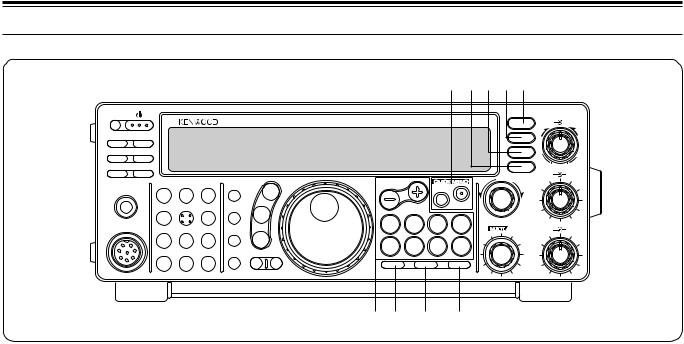
3 GETTING ACQUAINTED
PF
HF TRANSCEIVER TS-570D
ATT |
PRE-AMP |
|
|
|
|
|
|
VOX |
PROC |
|
|
|
|
|
|
SEND |
AT TUNE |
|
|
|
|
|
|
|
|
CH1 |
CH2 |
CH3 |
MIC |
LSB |
|
PHONES |
1 |
2 |
3 |
||||
|
USB |
||||||
|
|
|
|
||||
|
|
ANT |
REC |
FINE |
PWR |
CW |
|
|
|
4 |
5 |
6 |
|||
|
|
|
FSK |
||||
MIC |
NB |
AGC/TONE REV |
KEY |
|
|||
|
|
FM |
|||||
|
|
7 |
8 |
9 |
|
||
|
|
|
AM |
||||
|
|
|
F.LOCK |
|
DELAY |
MENU 1MHz |
|
CLR 0 ENT
!7Frequency control buttons
These buttons control functions related to selecting a frequency, a VFO, or a memory channel.
ïUP/DOWN buttons
Press to step through all Amateur bands consecutively {page 13} or to step the transceiver frequency in 1 MHz increments {page 29}. Also used for making selections from the Menu {page 16}, and to check Start and End frequencies for the Scan function {page 43}.
ïSPLIT button
Press to use split-frequency operation which allows a different transmit frequency and receive frequency {page 23}.
ïM/V button
Press to select either Memory or VFO mode {page 40}.
ïTF-SET button
While operating split-frequency, press to monitor or change your transmit frequency {page 23}.
ïA=B button
Press to copy the data in the currently selected VFO over to the other VFO {page 30}.
ïA/B button
Press to select either VFO A or VFO B {page 13}. Also, in menu mode, press to select either Menu A or Menu B {page 16}.
ïCLEAR button
Press to reset the RIT/XIT frequency offset to zero {pages 30, 32}.
ïRIT button
Press to switch ON or OFF the Receive Incremental Tuning function {page 30}.
ïXIT button
Press to switch ON or OFF the Transmit Incremental Tuning function {page 32}.
@1@2@3@4@5
|
|
|
|
|
|
|
DSP SLOPE |
|
|
|
|
|
|
N.R. |
|
HIGH |
LOW |
|
|
|
|
|
B.C. |
|
T |
|
|
|
|
|
|
|
|
U |
|
|
|
|
|
|
|
|
C |
|
|
|
|
|
|
|
|
W |
|
|
|
|
|
|
CW TUNE |
O |
|
|
|
|
|
|
|
L |
|
||
|
|
|
|
|
FILTER |
|
|
|
|
|
|
|
|
RIT/XIT |
|
AF |
RF |
|
UP |
|
|
|
|
4 |
6 |
|
DOWN |
|
|
|
|
|
|
|
|
|
MR |
|
|
|
|
|
|
|
|
|
|
|
|
|
|
|
|
|
|
|
M.IN |
– |
+ |
|
2 |
8 |
|
|
|
|
|
|
|||
|
|
|
|
|
|
|
|
|
|
|
|
|
|
|
|
0 |
10 |
SPLIT |
TF-SET |
A/B |
RIT |
|
CH |
IF SHIFT |
SQL |
|
|
|
|
|
|
||||
|
|
|
|
|
|
|
4 |
6 |
M/V |
A=B |
CLEAR |
XIT |
|
|
|
|
|
|
|
|
|
|
|
|
2 |
8 |
SCAN |
M>VFO |
M.IN |
|
|
|
|
|
|
|
|
|
|
|
|
|
0 |
10 |
!7!8 !9 @0
!8SCAN button
Press to start and stop Scan functions {pages 46, 47}.
!9M>VFO button
Press to transfer data from a memory channel to a VFO {page 42}.
@0M.IN button
Writes data into a memory channel {page 39} or selects Memory Scroll mode {page 41}.
@1Quick Memory buttons
Controls the Quick Memory function {page 44}.
ïM.IN button
Press to write data into Quick Memory {page 44}.
ïMR button
Press to recall data from Quick Memory {page 45}.
@2FILTER button
Press to select the receive filter bandwidth in SSB, CW, FSK, or AM mode {pages 36, 38}, or press to select either narrow-band or wide-band transmit deviation in FM mode {page 22}.
Note: Selecting the narrow filter bandwidth in SSB mode requires the optional YK-88SN-1 filter {page 36}.
@3CW TUNE button
Press to activate the automatic zero-beat function for CW mode {page 21}.
@4B.C. button
Press to switch ON or OFF the DSP Beat Cancel function {page 38}.
@5 N.R. button
Press to toggle between Noise Reduction 1, Noise Reduction 2, and OFF {page 38}.
8
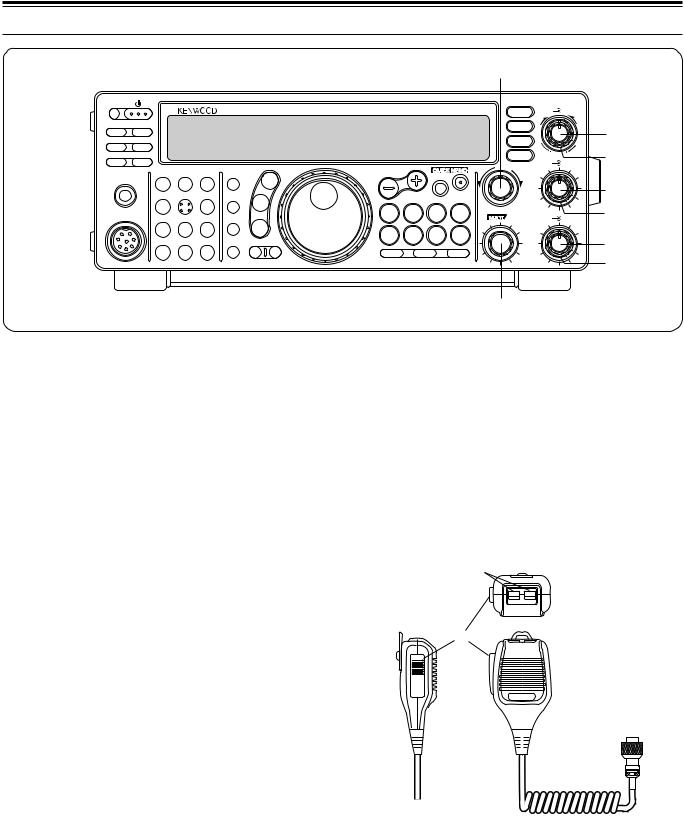
PF
HF TRANSCEIVER TS-570D
ATT |
PRE-AMP |
|
|
|
|
|
|
VOX |
PROC |
|
|
|
|
|
|
SEND |
AT TUNE |
|
|
|
|
|
|
|
|
CH1 |
CH2 |
CH3 |
MIC |
LSB |
|
PHONES |
1 |
2 |
3 |
||||
|
USB |
||||||
|
|
|
|
||||
|
|
ANT |
REC |
FINE |
PWR |
CW |
|
|
|
4 |
5 |
6 |
|||
|
|
|
FSK |
||||
MIC |
NB |
AGC/TONE REV |
KEY |
|
|||
|
|
FM |
|||||
|
|
7 |
8 |
9 |
|
||
|
|
|
AM |
||||
|
|
|
F.LOCK |
|
DELAY |
MENU 1MHz |
|
CLR 0 ENT
@6DSP SLOPE (HIGH) control
In SSB or AM mode, turn to change the high cut-off frequency of the receive pass band. Use the control to improve readability of the desired signal when higher frequency interference is present {page 37}.
@7DSP SLOPE (LOW) control
In SSB or AM mode, turn to change the low cut-off frequency of the receive pass band. Use the control to improve readability of the desired signal when lower frequency interference is present {page 37}.
@8RIT/XIT control
After switching ON the RIT or XIT function, turn to select the desired frequency offset {pages 30, 32}.
@9AF control
Turn to adjust the audio frequency gain {page 13}.
#0RF control
Turn to adjust the radio frequency gain {page 13}.
#1IF SHIFT control
Turn to slide the receive pass band either lower or higher in frequency when interference is present {page 36}.
#2SQL control
Used for muting (ìsquelchingî) the speaker output when no receive signal is present {page 14}.
#3MULTI/CH control
In VFO mode, turn to step the operating frequency up or down {page 29}. In memory channel mode, turn to select a memory channel {page 40}. Also used for selecting Menu numbers when accessing the Menu mode {page 16}, and as a selector to choose settings for various functions activated by front panel buttons.
3 GETTING ACQUAINTED
@8
|
|
|
|
|
|
DSP SLOPE |
|
|
|
|
|
|
|
|
N.R. |
HIGH |
LOW |
|
|
|
|
|
|
|
B.C. |
T |
|
|
|
|
|
|
|
|
|
U |
|
|
@6 |
|
|
|
|
|
|
L |
|
|
|
|
|
|
|
|
|
C |
|
|
|
|
|
|
|
|
|
W |
|
|
|
|
|
|
|
CW TUNE |
O |
|
|
|
|
|
|
|
|
|
|
|
@7 |
||
|
|
|
|
FILTER |
|
|
|
||
|
|
|
|
RIT/XIT |
AF |
RF |
|
|
|
|
UP |
|
|
4 |
6 |
|
|
||
DOWN |
|
MR |
|
|
|
|
|
|
|
|
|
|
|
|
|
|
|
@9 |
|
|
|
|
M.IN |
ñ |
+ |
2 |
|
8 |
|
|
|
|
|
|
|
|
|
||
|
|
|
|
|
|
0 |
10 |
|
#0 |
SPLIT |
TF-SET |
A/B |
RIT |
CH |
IF SHIFT |
SQL |
|
||
|
|
|
|
|
|||||
|
|
|
|
|
|
4 |
6 |
|
|
M/V |
A=B |
CLEAR |
XIT |
|
|
|
|
|
#1 |
|
|
|
|
|
|
2 |
|
8 |
|
SCAN |
M>VFO |
M.IN |
|
|
|
|
|
#2 |
|
|
|
|
|
|
|
0 |
10 |
|
|
#3
MICROPHONE
q UP/DWN buttons
Use these buttons to step up or down the VFO frequency, memory channels, or Menu selections. Press and hold down to continuously change the settings.
w PTT (Push-to-Talk) switch
The transceiver is placed in transmit mode when this non-locking switch is held down. Releasing the switch returns the transceiver to receive mode.
q
DWN UP
w
PTT
9

3 GETTING ACQUAINTED
REAR PANEL
q |
w |
e |
|
|
DC 13.8V |
ANT 2 |
ANT 1 |
|
|
AT |
|
|
|
GND |
|
|
r |
COM |
|
EXT.SP |
KEY PADDLE ACC 2 |
8Ω REMOTE |
t |
y u |
i o |
q ANT 1 and ANT 2 connectors
Connect the feed lines from your antennas to these connectors. Refer to pages 1 and 48 for details.
w AT connector
Mates with the connector on the cable supplied with the external antenna tuner. Refer to the instruction manual supplied with this tuner for more information.
e DC 13.8 V power input connector
Connect a 13.8 V DC power source {page 2}. Use the supplied cable with a regulated DC power supply.
i EXT SP jack
Mates with a 3.5 mm (1/8"), 2-conductor (mono) plug for connecting an external speaker {page 3}. Connecting an external speaker cuts off the audio automatically to the internal speaker.
o REMOTE connector
Mates with a 7-pin male DIN connector for connecting a linear amplifier {page 61}.
European versions only: Before connecting to the ACC 2 and
COM connectors, remove the protective covers.
r GND post
Connect a heavy gauge wire or copper strap between the ground post and the nearest earth ground {page 2}.
t COM connector
Mates with a 9-pin female RS-232C connector for connecting a computer via one of its serial communication ports {page 60}. Also used with the Quick Data Transfer function {page 60}.
y KEY and PADDLE jacks
The PADDLE jack mates with a 6.0 mm (1/4") 3-conductor plug for connecting a keyer paddle to the internal electronic keyer. The KEY jack mates with a 3.5 mm (1/8") 2-conductor plug for connecting an external key for CW operation. Read ìKeys and Keyboards for CW Operationî {page 3} before connecting to these jacks.
u ACC 2 connector
Mates with a 13-pin male DIN connector for connecting various accessory equipment {pages 61, 62}.
10
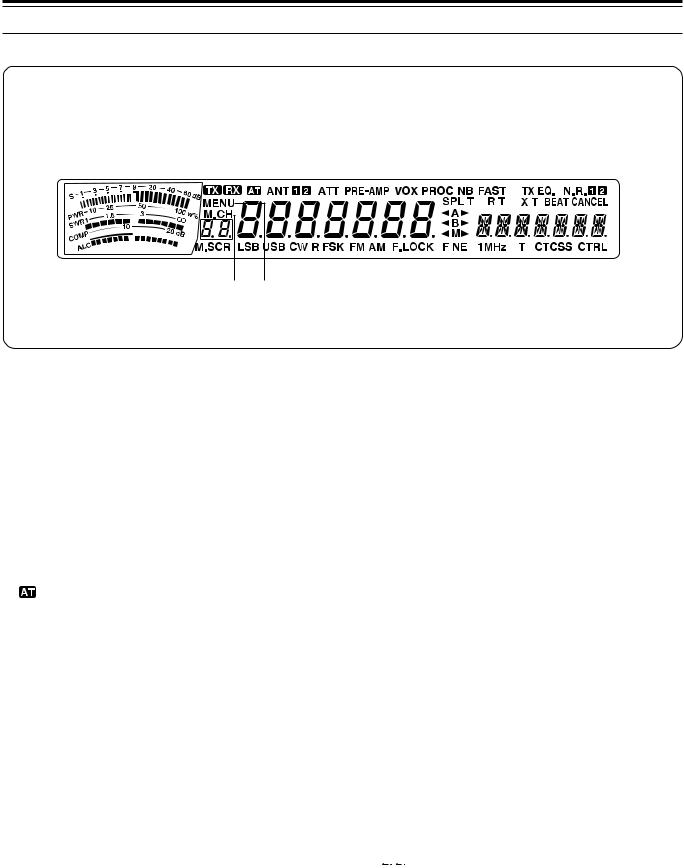
3 GETTING ACQUAINTED
DISPLAY
q |
w e r t y |
u i |
o !0 !2 !4!5 |
!6 !7 |
||||||||||||||||||||||||||||
|
|
|
|
|
|
|
|
|
|
|
|
|
!1 |
|
!3 |
|
|
|
|
|
|
|
|
|
||||||||
|
|
|
|
|
|
|
|
|
|
|
|
|
|
|
|
|
|
|
|
|
|
|
|
|
|
|
|
|
|
|
|
|
|
|
|
|
|
|
|
|
|
|
|
|
|
|
|
|
|
|
|
|
|
|
|
|
|
|
|
|
|
|
|
|
|
|
|
|
|
|
|
|
|
|
|
|
|
|
|
|
|
|
|
|
|
|
|
|
|
|
|
|
|
|
|
|
|
|
|
|
|
|
|
|
|
|
|
|
|
|
|
|
|
|
|
|
|
|
|
|
|
|
|
|
|
|
|
|
|
|
|
|
|
|
|
|
|
|
|
|
|
|
|
|
|
|
|
|
|
|
|
|
|
|
|
|
|
|
|
|
|
|
|
|
|
|
|
|
|
|
|
|
|
|
|
|
|
|
|
|
|
|
|
|
|
|
|
|
|
|
|
|
|
|
|
|
|
|
|
|
|
|
|
|
|
|
|
|
|
|
|
|
|
|
|
|
|
|
|
|
|
|
|
|
|
|
|
|
|
|
|
|
|
|
|
|
|
|
|
|
|
|
|
|
|
|
|
|
|
|
|
|
|
|
|
|
|
|
|
|
|
|
|
@0!9 !8
q METER
While receiving, serves as an S-meter to measure and display the received signal strength. While transmitting, serves as a calibrated power meter plus an ALC meter, an SWR meter, or a Speech Processor compression meter. The Peak Hold function holds each reading for about 2.5 seconds.
w 
Appears while the transceiver is in the transmit mode.
e 
Appears while the squelch is open in the receive mode.
r
Appears while the internal antenna tuner {page 52} or an external antenna tuner is in-line.
t 


Either ìANT 1î or ìANT 2î appears depending on whether the Antenna 1 connector or the Antenna 2 connector is selected {page 48}.
y ATT
Appears when the receive attenuator is ON {page 37}.
u PRE -AMP
Appears when the receive preamplifier is ON {page 37}.
i VOX
Appears when the Voice-Operated Transmit function is ON {page 31}. For CW operation, appears when the Break-in function is ON {page 34}.
o PROC
Appears when Speech Processor is ON {page 32}.
!0NB
Appears when Noise Blanker is ON {page 36}.
!1SPLIT
Appears when the transmit frequency differs from the receive frequency {page 23}.
!2FAST
Appears when a fast time constant is selected for the Automatic Gain Control function {page 30}.
!3RIT
Appears when Receive Incremental Tuning is ON {page 30}.
!4XIT
Appears when Transmit Incremental Tuning is ON {page 32}.
!5TX EQ.
Appears when the TX Equalizer function is ON {page 33}.
!6


Either ìN.R. 1î or ìN.R. 2î appears depending on whether Noise Reduction 1 or Noise Reduction 2 is selected {page 38}.
!7




Appears when Beat Cancel is ON {page 38}.
!8MENU
Appears while Menu mode is being accessed {page 16}.
!9M.CH
Appears while Memory Recall or Memory Scroll is being used {page 40}.
@0

Shows 2-digit information such as a menu number or a memory channel number.
11
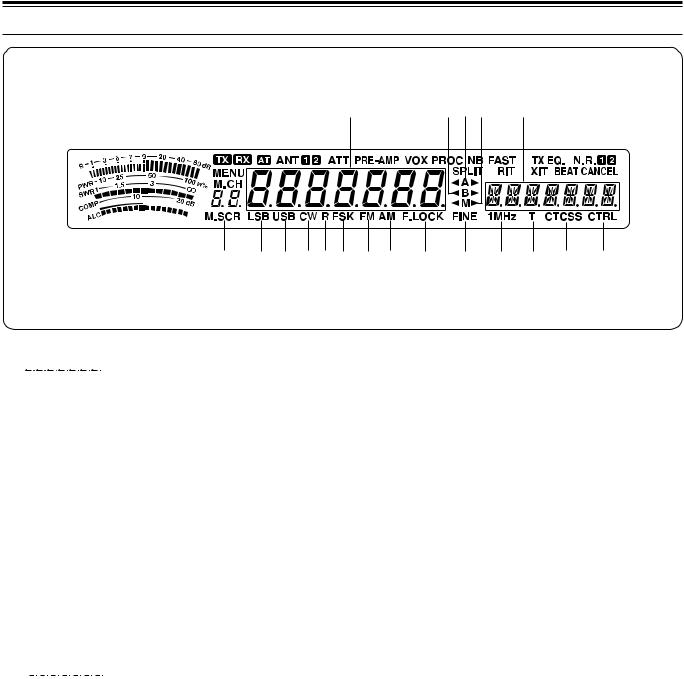
3 GETTING ACQUAINTED
@1 |
@3@2@4 |
@5 |
@6 @7 @8@9#0#1 #2#3 #4 |
#5 #6 #7 #8 #9 |
@1






Shows the current operating frequency. Also shows Menu selections while in Menu mode.
@2

ìtAî or ìAsî appears while VFO A is being selected {page 13}. ìAî appears while MenuA is being accessed {page 16}.
@3

#0R
Appears while the sideband is being reversed for CW {page 21}. Also appears while the mark and space frequency relationship is being reversed for FSK {page 26}.
#1FSK
Appears when in Frequency Shift Keying mode {page 26} or when you select one of the digital operation filters via Menu No. 32 in SSB mode {page 27}.
ìtBî or ìBsî appears while VFO B is being selected {page 13}. ìBî appears while Menu B is being accessed {page 16}.
@4

ìtMî or ìMsî appears while a simplex memory channel is being selected {page 40}. ìtMsî appears while a split-frequency memory channel is being selected {page 40}.
@5 






Shows menu information while Menu A or B is being accessed. Also shows the transmit frequency during split-frequency operation, and the RIT/XIT offset frequency when these functions are ON.
@6M.SCR
Appears while Memory Scroll is being used {page 41}.
@7LSB
Appears when in Lower Sideband mode {page 14}.
@8USB
Appears when in Upper Sideband mode {page 14}.
@9CW
Appears when in CW mode {page 14}.
#2FM
Appears when in FM mode {page 14}.
#3AM
Appears when in AM mode {page 14}.
#4F.LOCK
Appears when the Frequency Lock function is ON {page 48}.
#5FINE
Appears when the Fine function is ON {page 29}.
#61MHz
Appears when the 1 MHz Step function is ON {page 29}.
#7T
Appears when the Subtone function is ON {page 24}.
#8CTCSS
Appears when CTCSS is ON {page 25}.
#9CTRL
Appears while Quick Data Transfer {page 50} or Computer Control {page 51} is being used.
12
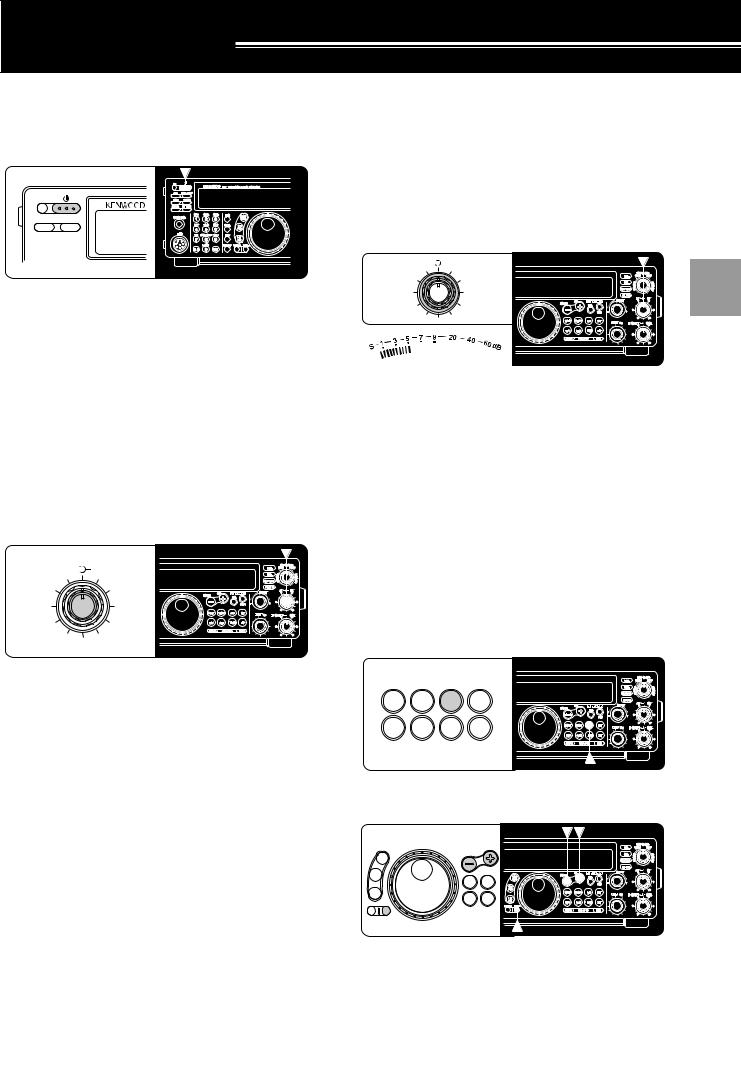
OPERATING BASICS
SWITCHING POWER ON/OFF
Switch ON the DC power supply, then press and hold down [ ] (POWER) until ìHELLOî appears on the display. Release [
] (POWER) until ìHELLOî appears on the display. Release [ ] (POWER) when you see ìHELLOî.
] (POWER) when you see ìHELLOî.
PF
ATT PRE-AMP
ïAfter the ìHELLOî message, the frequency and other indicators appear.
To switch OFF the transceiver, press [ ] (POWER).
] (POWER).
ïAfter the transceiver has been switched ON, it can then be switched OFF or ON by using only the power switch on the DC power supply.
ADJUSTING VOLUME
AUDIO FREQUENCY (AF) GAIN
Turn the AF control clockwise to increase the audio level and counterclockwise to decrease the level.
AF  RF
RF
4 6
QUICK MEMO
2 |
8 |
0 10
Note: The position of the AF control does not affect the volume of
“beeps” caused by pressing buttons nor the CW transmit sidetone.
Also, the audio level for Packet operation is independent of the AF control setting.
RADIO FREQUENCY (RF) GAIN
Usually, set the RF control fully clockwise. If you are having trouble hearing the desired signal due to excessive atmospheric noise or interference from other stations, it may help to reduce the RF gain.
To do this, take note of the peak S-meter reading of the desired signal. Turn the RF control counterclockwise until the S-meter reads the peak value that you noted. Signals that are weaker than this level will be attenuated. Reception of the station will be easier.
AF  RF
RF
4 6
2 |
8 |
QUICK MEMO
0 10
Depending on the type and gain of your antenna, and the condition of the band, you may prefer leaving the RF control turned counterclockwise by some amount instead of turning it fully clockwise. When in FM mode, always set the RF gain control fully clockwise.
SELECTING VFO A OR VFO B
VFO A and VFO B are modes that allow any desired frequency to be selected within the frequency range of the transceiver. VFO A and VFO B function independently so that different or the same frequencies can be selected for each VFO.
Press [A/B] to toggle between VFO A and VFO B.
ïìtAî or ìtBî appears and shows which VFO is selected.
SPLIT |
TF-SET |
A/B |
RIT |
|
|
|
QUICK MEMO |
M/V |
A=B |
CLEAR |
XIT |
SELECTING A BAND
UP
DOWN
LSB
USB
CW |
QUICK MEMO |
FSK |
|
SPLIT TF-SET
FM
AM
M/V A=B
MENU 1MHz
1If ì1MHzî is visible on the display, first press [1MHz] to exit from the 1MHz Step mode.
ï ì1MHzî should disappear.
2Press [UP] or [DOWN].
ïHolding down either button consecutively steps the transceiver to each band.
1
2
3
4
5
6
7
8
9
10
11
12
13
14
15
16
13
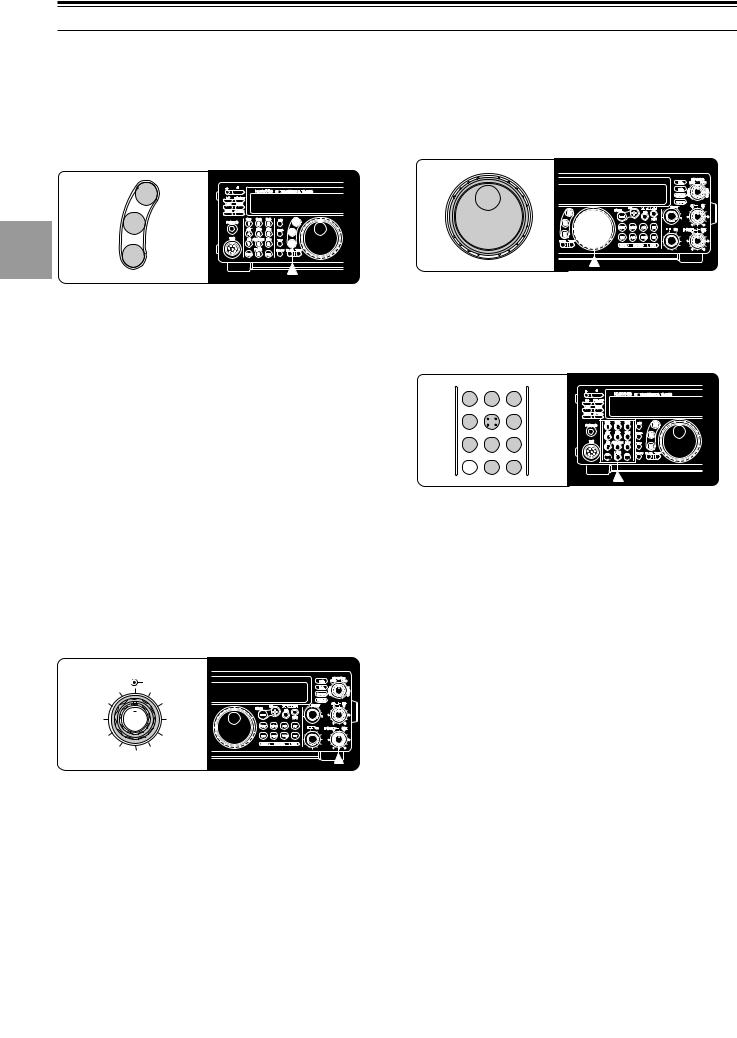
1
2
3
4
4 OPERATING BASICS
SELECTING A MODE
Depending on which operating mode you want to select, press the [LSB/USB], [CW/FSK], or [FM/AM] button. The second function on each button is accessed by again pressing the same button. For example, repeatedly pressing [LSB/USB] toggles between LSB and USB modes.
SELECTING A FREQUENCY
There are two simple methods to select a frequency.
AManual Tuning
Turn the Tuning control or press Mic [UP]/[DWN] to select the exact frequency.
LSB
USB
QUICK MEMO
CW
FSK
FM
AM
|
|
|
|
|
|
|
5 |
|
In SSB mode, the transceiver automatically selects LSB |
||||
|
|
for frequencies lower than 9.5 MHz, and selects USB for |
||||
|
|
9.5 MHz or higher frequencies if the Tuning control, the |
||||
|
||||||
6 |
|
MULTI/CH control, or Mic [UP]/[DWN] is used to cross |
||||
|
the frequency of 9.5 MHz. This is also true if using the |
|||||
|
|
front panel [UP] or [DOWN] button when the 1 MHz |
||||
|
|
Step mode is used. |
||||
7 |
|
|||||
|
ADJUSTING SQUELCH |
|||||
|
|
|||||
|
|
The purpose of squelch is to silence audio output from |
||||
8 |
|
|||||
|
the speaker when no signal is present. When squelch |
|||||
|
is set correctly, you will hear sound only while a station |
|||||
|
|
is actually being received. The point at which ambient |
||||
|
|
|||||
9 |
|
noise on a frequency just disappears, called the squelch |
||||
|
threshold, depends on the frequency. |
|||||
|
Turn the SQL control clockwise to just eliminate the |
|||||
|
|
|||||
|
|
background noise when no signal is present. Many |
||||
|
|
|||||
10 |
|
operators prefer leaving the squelch control fully |
||||
|
counterclockwise unless operating full-carrier modes |
|||||
|
|
such as FM or AM. |
||||
|
|
|
|
|
|
|
|
|
|
|
|
|
|
11 |
|
|
IF SHIFT |
|
SQL |
|
|
|
|
||||
|
4 |
6 |
||||
|
|
|
|
|
||
|
|
|
|
|
QUICK MEMO |
|
|
|
|
|
|
|
|
|
2 |
8 |
||||
12 |
||||||
0 |
10 |
|||||
|
|
|
|
|
||
|
|
|
|
|
|
|
|
|
|
|
|
|
|
13 |
|
|
|
|
|
|
|
|
|
|
|
|
|
|
|
|
|
|
|
|
14 |
|
|
|
|
|
|
|
|
|
|
|
|
|
|
|
|
|
|
|
|
15 |
|
|
|
|
|
|
|
|
|
|
|
|
|
|
|
|
|
|
|
|
16 |
|
|
|
|
|
|
|
|
|
|
|
|
|
BDirect Frequency Entry (Keypad)
Press [ENT], then directly enter the desired frequency using the numeric keypad. For details, refer to ìDirect Frequency Entryî {page 29}.
CH1 CH2 CH3
1 2 3
ANT REC FINE
4 5 6
NB AGC/TONE REV
7 8 9
F.LOCK
CLR 0 ENT
FRONT PANEL METER
The multifunction meter measures the parameters in the table below. The appropriate meters automatically become functional according to which state the transceiver is in. Peak readings for the S-meter, ALC, SWR, COMP, and PWR functions are held for a brief moment.
Scale |
Display |
Functional State |
|
|
|
S |
Received signal strength |
Receive |
PWR |
Transmit output power |
Transmit |
|
|
|
ALC |
Automatic level control |
Transmit |
|
status |
|
SWR |
Antenna system standing |
Transmit |
|
wave ratio |
|
COMP |
Speech compression level |
Transmit plus |
|
when using the Speech |
SSB/AM/FM mode |
|
Processor {page 32} |
plus [PROC] ON |
|
|
|
Note:
The COMP meter functions only when the Speech Processor is
ON while using SSB, FM, or AM mode. When the COMP meter appears, the SWR meter disappears.
Peak Hold readings cannot be deactivated on this transceiver.
14
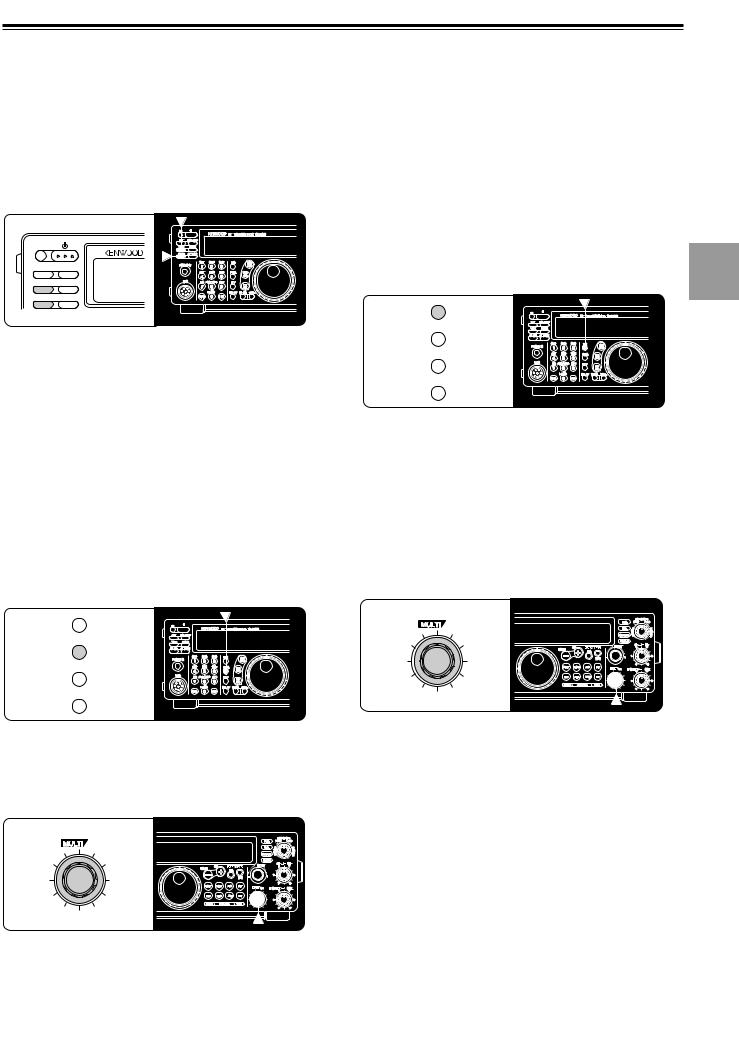
|
4 OPERATING BASICS |
TRANSMITTING |
3 Press [PWR] again to complete the setting. |
Methods for transmitting include the following: |
Note: The transmit power can be separately selected for the AM |
mode independent of the other modes. |
|
ï Press [SEND]. |
|
ïPress and hold down Mic [PTT].
ïConnect a key or keyer paddle, select the CW mode, press [VOX] to switch ON the Break-in function, and close the key or keyer paddle.
PF |
|
ATT |
PRE-AMP |
VOX |
PROC |
SEND |
AT TUNE |
For a detailed explanation on transmitting, refer to sections in ìBASIC COMMUNICATINGî beginning on page 20.
Note: When CW, FSK, or AM is selected, the transmit carrier level is automatically adjusted according to the selected mode.
MICROPHONE GAIN
The microphone gain is finely adjustable in the SSB or AM mode. A different level can be selected between when the Speech Processor {page 32} is ON and when the Speech Processor is OFF.
1Press [MIC].
ïThe current microphone gain level appears. The default is 50.
MIC
PWR
KEY
DELAY
SELECTING TRANSMIT POWER
Itís wise, and required by law, to select the lowest transmit power that allows reliable communication. Reducing power lowers the risk of interfering with others on the band. On this transceiver, it is possible to change output power while transmitting.
1Press [PWR].
ï The current transmit power appears.
MIC
PWR
KEY
DELAY
2Turn the MULTI/CH control counterclockwise to reduce power and clockwise to increase power.
ï The displayed transmit power changes.
CH
QUICK MEMO
ïSSB/CW/FSK/FM: Transmit power can be changed from 5 W to 100 W in steps of 5 W.
ïAM: Transmit power can be changed from 5 W to 25 W in steps of 5 W.
2Press [SEND] or press and hold Mic [PTT]. ï ìTXî appears.
3SSB: While speaking into the microphone, adjust the MULTI/CH control so that the ALC meter reflects according to your voice level.
AM: While speaking into the microphone, adjust the MULTI/CH control so that the calibrated power meter slightly reflects according to your voice level.
CH
QUICK MEMO
4Press [SEND] again or release Mic [PTT]. ï ìTXî disappears.
5 Press [MIC] again.
For the FM mode, set the microphone gain by accessing Menu No. 17 {page 17} and selecting either ìLî (low) or ìHî (high).
Note:
When using the optional MC-90 microphone in FM mode, select high microphone gain. The microphone sensitivity is low in FM mode and this may cause insufficient modulation.
When using a microphone that has an amplifier, be careful that the output of the amplifier is not too large.
1
2
3
4
5
6
7
8
9
10
11
12
13
14
15
16
15
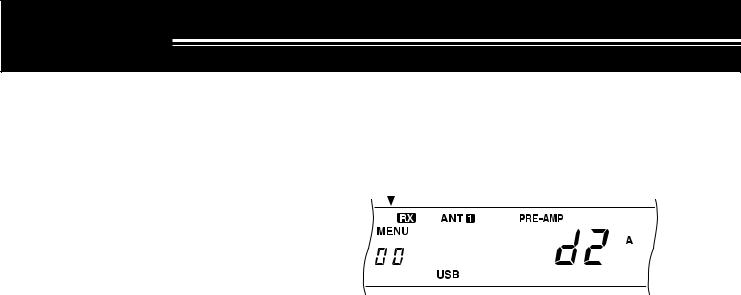
MENU SETUP
WHAT IS A MENU?
Many functions on this transceiver are selected or configured via a software-controlled Menu instead of physical controls on the transceiver. Once familiar with the Menu system, you will appreciate the versatility it offers. No longer is the number and complexity of features restricted by the physical controls and switches on the front panel.
MENU A/ MENU B
The transceiver has two menus. These menus are called Menu Aand Menu B.The menus contain identical functions; however, each menu can be configured independently.
For example, you may enjoy two different kinds of operating activities but you like to configure the transceiver differently for each activity. Menu Acould be configured with one set of transmit signal characteristics, DSP settings, programmable buttons, frequency steps, etc. Menu B could be configured completely differently. By switching from Menu Ato Menu B, you could instantly change Menu configuration and button assignment to suit your current operating style. Or, two operators may share a single transceiver. By dedicating one Menu per operator, each would always enjoy the best configuration.
Note: The COM communication parameter setting in Menu No. 35 is shared by Menu A and Menu B.
MENU ACCESS
The following procedure explains how to check or change any of the Menu items.
1Press [MENU].
ï ìMENUî appears.
2Press [A/B] to toggle Menu A or Menu B.
ïìAî or ìBî appears to show which Menu is selected.
3Turn the MULTI/CH control to select the desired Menu No.
ïEach time you change the Menu No. , you will see a scrolling message that briefly describes the current Menu No.
4Press [UP], [DOWN], Mic [UP], or Mic [DWN] to change the current selection for this Menu item.
5Press [MENU] or [CLR] to exit Menu mode.
16

5 MENU SETUP
MENU CONFIGURATION
Group |
Menu |
Function |
Selections |
Default |
Page |
|
No. |
Ref. |
|||||
|
|
|
|
|||
Operator |
00 |
Display brightness |
OFF/ d4/ d3/ d2/ d1 |
d2 |
49 |
|
Interface |
|
d1: maximum, d4: minimum |
|
|
|
|
|
|
|
|
|
|
|
|
01 |
Beep output level |
OFF, 1 to 9 |
4 |
49 |
|
|
|
1: minimum, 9: maximum |
|
|
|
|
|
|
|
|
|
|
|
Encoder |
02 |
Frequency step size for the [UP]/[DOWN] |
100/ 500/ 1000 kHz |
1000 kHz |
29 |
|
|
|
buttons in the 1 MHz step mode |
|
|
|
|
|
|
|
|
|
|
|
|
03 |
Frequency step size for the MULTI/CH control |
1/ 5/ 10 kHz |
10 kHz |
29 |
|
|
|
for SSB, CW, FSK, or AM mode |
|
|
|
|
|
|
|
|
|
|
|
|
04 |
Frequency step size for the MULTI/CH control |
1/ 5/ 10/ 12.5/ |
10 kHz |
29 |
|
|
|
for FM mode |
20/ 25 kHz |
|
|
|
|
|
|
|
|
|
|
|
05 |
Rounds off VFO frequencies changed by using |
ON/ OFF |
ON |
29 |
|
|
|
the MULTI/CH control |
|
|
|
|
|
|
|
|
|
|
|
|
06 |
Frequency step size for the MULTI/CH control |
9 kHz/ 10 kHz |
See page |
29 |
|
|
|
for AM mode in the AM broadcast band |
|
reference |
|
|
|
|
|
|
|
|
|
Memory |
07 |
Memory-VFO split operation |
ON/ OFF |
OFF |
41 |
|
Channel |
|
|
|
|
|
|
08 |
Tunable (ON) or fixed (OFF) memory channel |
ON/ OFF |
OFF |
41 |
||
|
||||||
|
|
frequencies |
|
|
|
|
|
|
|
|
|
|
|
Scan |
09 |
Program scan hold |
ON/ OFF |
OFF |
46 |
|
|
|
|
|
|
|
|
|
10 |
Scan resume method |
Time-operated/ |
Time- |
47 |
|
|
|
|
Carrier-operated |
operated |
|
|
|
|
|
|
|
|
|
Antenna Tuner |
11 |
Antenna tuner operation while receiving signals |
ON/ OFF |
OFF |
52 |
|
|
|
|
|
|
|
|
DSP |
12 |
Time constant for the noise reduction 2 function |
7.5/ 20 ms |
20 ms |
38 |
|
|
|
|
|
|
|
|
TX |
13 |
TX filter bandwidth for SSB or AM mode |
2.4/ 2.0 kHz |
2.4 kHz |
33 |
|
|
|
|
|
|
|
|
|
14 |
TX equalizer |
OFF/ Hb/ FP/ bb/ c |
OFF |
33 |
|
|
|
OFF: flat, Hb: high boost, FP: formant pass, |
(U: not currently |
|
|
|
|
|
bb: bass boost, c: conventional |
available) |
|
|
|
|
15 |
Speech processor compression level |
0 to 25 dB in |
10 dB |
32 |
|
|
|
|
steps of 5 dB |
|
|
|
|
|
|
|
|
|
|
|
16 |
VOX gain |
0 to 9 |
4 |
31 |
|
|
|
0: minimum, 9: maximum |
|
|
|
|
|
|
|
|
|
|
|
|
17 |
Microphone gain for FM mode |
L/ H |
L |
22 |
|
|
|
L: low, H: high |
|
|
|
|
|
|
|
|
|
|
|
|
18 |
Subaudible tone frequency for FM mode |
See page reference |
88.5 Hz |
25 |
|
|
|
|
|
|
|
|
|
19 |
Type of subaudible tone for FM mode |
B/ C |
See page |
25 |
|
|
|
B: burst, C: continuous |
|
reference |
|
|
|
|
|
|
|
|
|
CW |
20 |
CW RX pitch/ TX sidetone frequency |
400 to 1000 Hz in |
800 Hz |
21 |
|
|
|
|
steps of 50 Hz |
|
|
|
|
|
|
|
|
|
|
|
21 |
TX sidetone volume |
OFF, 1 to 9 |
5 |
21 |
|
|
|
|
|
|
|
|
|
22 |
Semi-automatic key (ìBugî) function |
ON/ OFF |
OFF |
35 |
|
|
|
|
|
|
|
|
DRU |
23 |
Playback repeat |
ON/ OFF |
OFF |
35, 53 |
|
|
24 |
Interval between repeated playbacks |
0 to 60 sec |
10 sec |
54 |
|
|
|
|
|
|
|
|
|
25 |
Playback volume |
OFF, 1 to 9 |
4 |
54 |
|
|
|
1: minimum, 9: maximum |
|
|
|
|
|
|
|
|
|
|
17

5 MENU SETUP
Group |
|
Menu |
|
Function |
|
Selections |
Default |
Page |
|
No. |
|
|
Ref. |
||||
|
|
|
|
|
|
|
||
CW |
26 |
CW Auto weighting |
|
ON/ OFF |
ON |
34 |
||
|
|
|
|
|
|
|
||
|
27 |
CW Auto weighting reversed |
|
ON/ OFF |
OFF |
34 |
||
|
|
|
|
|
|
|
||
|
28 |
Keying priority over playback |
|
ON/ OFF |
OFF |
35 |
||
|
|
|
|
|
|
|
|
|
Digital |
29 |
FSK shift |
|
|
170/ 200/ 425/ 850 Hz |
170 Hz |
26 |
|
Operation |
|
|
|
|
|
|
|
|
30 |
Key-down polarity for FSK mode |
|
ON (space)/ OFF (mark) |
OFF |
26 |
|||
|
|
|||||||
|
|
|
|
|
|
|
|
|
|
31 |
Tone frequencies for FSK mode |
|
2125/ 1275 Hz |
2125 Hz |
26 |
||
|
|
|
2125: 2125 Hz mark, 1275: 1275 Hz mark |
|
|
|
||
|
|
|
|
|
|
|
|
|
|
32 |
Filter bandwidth for digital operation |
|
OFF/ 1200 bps/ |
OFF |
27 |
||
|
|
|
(SSB and FM modes only) |
|
300 bps/ PSK |
|
|
|
|
|
|
|
|
|
|
|
|
|
33 |
AF input level for digital operation |
|
0/ 1/ 2 |
2 |
27 |
||
|
|
|
(excluding CW and FSK modes) |
|
|
|
|
|
|
|
|
0: minimum, 2: maximum |
|
|
|
||
|
|
|
|
|
|
|
||
|
|
|
|
|
|
|
|
|
|
34 |
AF output level for digital operation |
|
0 to 9 |
4 |
27 |
||
|
|
|
0: minimum, 9: maximum |
|
|
|
|
|
|
|
|
|
|
|
|
||
Computer |
35 |
Communication parameters for COM connector |
12-1/ 24-1/ 48-1/ 48-2/ |
96-1 |
51 |
|||
Interface |
|
|
Setting Transfer Rate (bps) Stop Bits |
96-1/ 192-1/ 384-1/ |
|
|
||
|
|
|
12-1 |
1200 |
1 |
576-1 |
|
|
|
|
|
24-1 |
2400 |
1 |
Note: To reliably use the |
|
|
|
|
|
48-1 |
4800 |
1 |
|
|
|
|
|
|
38400 or 57600 bps transfer |
|
|
|||
|
|
|
48-2 |
4800 |
2 |
rates, the serial port of your |
|
|
|
|
|
96-1 |
9600 |
1 |
computer must support these |
|
|
|
|
|
high-speed communications |
|
|
|||
|
|
|
192-1 |
19200 |
1 |
|
|
|
|
|
|
parameters. |
|
|
|||
|
|
|
384-1 |
38400 |
1 |
|
|
|
|
|
|
576-1 |
57600 |
1 |
|
|
|
|
|
|
|
|
|
|
||
Data Transfer |
36 |
Data transfer enable |
|
ON/ OFF |
OFF |
50 |
||
|
|
|
|
|
|
|
||
|
37 |
Method of receiving transferred data |
|
ON/ OFF |
OFF |
50 |
||
|
|
|
ON: Transfer to VFO |
|
|
|
|
|
|
|
|
OFF: Transfer to quick memory |
|
|
|
|
|
|
|
|
|
|
|
|
|
|
TX |
38 |
TX inhibit |
|
|
ON/ OFF |
OFF |
33 |
|
|
|
|
|
|
|
|
||
|
39 |
Linear amplifier control relay |
|
ON/ OFF |
OFF |
61 |
||
|
|
|
|
|
|
|||
Transverter |
40 |
Enables/disables the 50, 144, or 430 MHz |
OFF/ 50/ 144/ 430 MHz |
OFF |
51 |
|||
|
|
|
transverter function. |
|
|
|
|
|
|
|
|
|
|
|
|||
PF |
41 |
Programs the [PF] button on the front panel. |
See page reference |
51 |
49 |
|||
|
|
|
|
|
|
|
(Voice 1) |
|
|
|
|
|
|
|
|
||
|
42 |
Programs the Mic [PF1] button. |
|
See page reference |
64 |
49 |
||
|
|
|
|
|
|
|
([A/B]) |
|
|
43 |
Programs the Mic [PF2] button. |
|
See page reference |
62 |
49 |
||
|
|
|
|
|
|
|
([SPLIT]) |
|
|
|
|
|
|
|
|
||
|
44 |
Programs the Mic [PF3] button. |
|
See page reference |
65 |
49 |
||
|
|
|
|
|
|
|
([M/V]) |
|
|
|
|
|
|
|
|
||
|
45 |
Programs the Mic [PF4] button. |
|
See page reference |
50 |
49 |
||
|
|
|
|
|
|
|
(Monitor) |
|
|
|
|
|
|
|
|
||
RX |
46 |
IF filter bandwidth |
|
OFF/ |
OFF |
36 |
||
|
|
|
|
|
|
1800/ 500/ 270 Hz |
|
|
|
|
|
|
|
|
|
|
|
18

5 MENU SETUP
Group |
Menu |
Function |
Selections |
Default |
Page |
|
No. |
Ref. |
|||||
|
|
|
|
|||
|
47 |
Transmitted-signal monitor volume |
OFF, 1 to 9 |
OFF |
33 |
|
|
1: minimum, 9: maximum |
|||||
|
|
|
|
|
||
|
|
|
|
|
|
|
|
48 |
Auto zero-beat with RIT |
ON/ OFF |
OFF |
21 |
|
|
|
|
|
|
|
|
Enhanced |
49 |
Keyer locked-weight change |
2.5:1 to 4.0:1 |
3.0:1 |
35 |
|
|
|
|
|
|
||
|
|
RX equalizer |
OFF/ Hb/ FP/ bb/ c |
|
|
|
|
50 |
OFF: flat, Hb: high boost, FP: formant pass, |
(U: not currently |
OFF |
30 |
|
|
|
bb: bass boost, c: conventional |
available) |
|
|
|
|
|
|
|
|
|
|
|
51 |
Noise reduction 1 level change |
Auto, 1 to 9 |
Auto |
38 |
|
|
|
|
|
|
|
CROSS REFERENCE FOR MENU
FUNCTIONS
Use this table arranged by subject to help you locate the function that you are interested in checking or changing. Consult ìMENU CONFIGURATIONî {page 17} for more detail on each function.
Function |
Menu |
|
No. |
||
|
||
AMPLIFIER |
|
|
Linear amplifier relay |
39 |
|
ANTENNA TUNER (AT) |
|
|
RX enable/ disable |
11 |
|
BEEP FUNCTIONS |
|
|
|
|
|
Beep level |
01 |
|
CW |
|
|
Auto weighting |
26 |
|
Auto weighting reversed |
27 |
|
Keying priority over playback |
28 |
|
RX pitch |
20 |
|
Semi-automatic key (ìBugî) function |
22 |
|
TX sidetone frequency |
20 |
|
TX sidetone volume |
21 |
|
DATA TRANSFER |
|
|
Transfer enable |
36 |
|
Transfer method |
37 |
|
DIGITAL OPERATION |
|
|
AF input (MCP/TNC TX) |
33 |
|
AF output (MCP/TNC RX) |
34 |
|
Filter bandwidth |
32 |
|
DISPLAY |
|
|
Brightness |
00 |
|
DRU-3A DIGITAL RECORDING SYSTEM (DRS) |
|
|
Playback repeat |
23 |
|
Playback repeat interval |
24 |
|
Playback volume |
25 |
|
DIGITAL SIGNAL PROCESSING |
|
|
NR2 time constant |
12 |
|
FM |
|
|
Microphone gain |
17 |
|
Subtone frequency |
18 |
|
Subtone type |
19 |
Function |
Menu |
|
No. |
||
|
||
FREQUENCY STEPS |
|
|
MULTI/CH control (SSB, CW, FSK, AM) |
03 |
|
|
MULTI/CH control (FM) |
04 |
|
|
MULTI/CH control (AM and AM broadcast only) |
06 |
|
|
MULTI/CH control (rounds off frequencies) |
05 |
|
|
[UP]/[DOWN] buttons |
02 |
|
|
FSK |
|
|
|
Polarity (space/mark) |
30 |
|
|
Shift |
29 |
|
|
Tone |
31 |
|
|
MEMORY CHANNELS |
|
|
|
Memory-VFO split operation |
07 |
|
|
Tunable/fixed frequency |
08 |
|
|
PROGRAMMABLE BUTTONS |
|
|
|
[PF] button |
41 |
|
|
Mic [PF1] button |
42 |
|
|
Mic [PF2] button |
43 |
|
|
Mic [PF3] button |
44 |
|
|
Mic [PF4] button |
45 |
|
|
RECEIVE |
|
|
|
IF filter bandwidth |
46 |
|
|
REAR PANEL |
|
|
|
COM communication parameters |
35 |
|
|
SCAN |
|
|
|
Hold (Program Scan) |
09 |
|
|
Resume (Time or Carrier) |
10 |
|
|
SPEECH PROCESSOR |
|
|
|
Compression level |
15 |
|
|
TRANSMIT |
|
|
|
Bandwidth (SSB or AM) |
13 |
|
|
Equalizer |
14 |
|
|
Inhibit |
38 |
|
|
TRANSVERTER |
|
|
|
Enable/disable |
40 |
|
|
VOICE-OPERATED TRANSMIT (VOX) |
|
|
|
Gain |
16 |
|
19
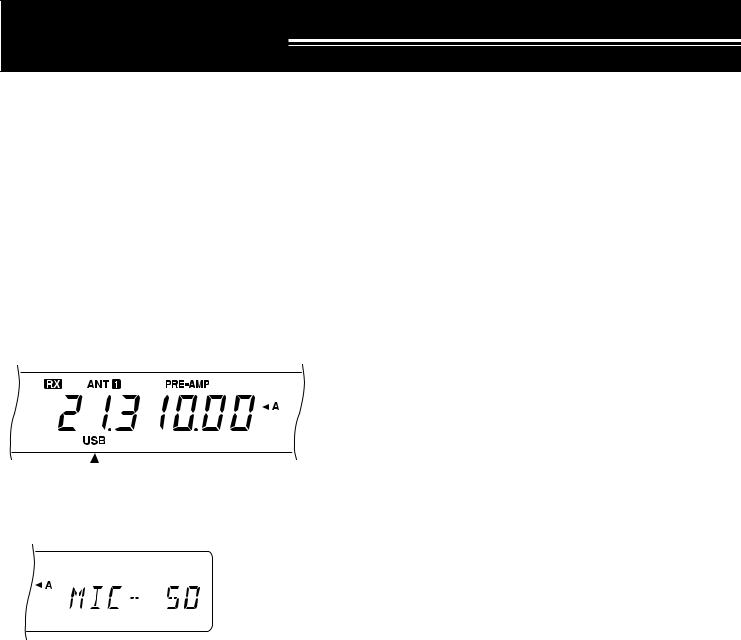
BASIC COMMUNICATING
SSB TRANSMISSION
SSB is now the most commonly-used mode on the HF Amateur bands. Compared with other voice modes, SSB requires a narrow bandwidth for communications. SSB also allows long distance communication with minimum transmit power. These reasons, combined with the fact that modern Amateur transceivers deliver reasonably good audio quality, make SSB the mode that most prefer on HF.
Refer, if necessary, to ìOPERATING BASICSî beginning on page 13 for receiving details.
1 Select the operating frequency.
2Press [LSB/USB] to select either upper or lower sideband mode.
ïìLSBî or ìUSBî appears to show which sideband is selected.
3Press [MIC] to activate the Microphone Gain Setting function.
ï The current gain level appears
4Press and hold down Mic [PTT], or press [SEND].
ïìRXî disappears and ìTXî appears.
ïRefer to ìVOXî {page 31} for information on automatic TX/RX switching.
5Speak into the microphone and adjust the MULTI/CH control so that the ALC meter reflects according to your voice level.
ïSpeak in a normal tone and level of voice. Speaking too close to the microphone, or too loudly, may increase distortion and reduce intelligibility.
ïYou may want to use the Speech Processor. Refer to ìSPEECH PROCESSORî {page 32} for details.
6Release Mic [PTT], or press [SEND] again, to return to the receive mode.
ï ìTXî disappears and ìRXî appears.
7Press [MIC] again to quit the Microphone Gain Setting function.
Refer to ìCOMMUNICATING AIDSî beginning on page 29 for information about additional useful functions for operating.
20

6 BASIC COMMUNICATING
CW TRANSMISSION
CW operators know that this mode is a reliable method of communicating under the worst conditions. Although itís true that newer digital modes rival CW as being equally as useful in poor conditions, these modes do not have the long history of service yet nor the simplicity that CW can have.
This transceiver has a built-in electronic keyer that supports a variety of functions. For details on using these functions, refer to ìELECTRONIC KEYERî {page 34}.
Refer, if necessary, to ìOPERATING BASICSî beginning on page 13 for receiving details.
1 Select the operating frequency.
2Press [CW/FSK] to select CW mode. ï ìCWî appears.
ïTo tune in another station so your transceiver is precisely on their frequency, use Auto Zero-beat. Refer to ìAUTO ZERO-BEATî.
ïIf you wish, you can press [REV] to switch receive from the default upper sideband to the lower sideband. ìRî will appear.
3Press [SEND].
ïìRXî disappears and ìTXî appears.
ïNo transmit carrier level adjustment is necessary.
ïRefer to ìCW BREAK-INî {page 34} for information on automatic TX/RX switching.
4Begin sending.
ïAs you transmit, you should be hearing a sidetone that lets you monitor your own sending. Refer to ìTX SIDETONE/ RX PITCH FREQUENCYî.
5 Press [SEND] again to return to the receive mode.
ïìTXî disappears and ìRXî appears.
Note: Auto Zero-beating may fail if there are other interfering signals on frequency.
Refer to ìCOMMUNICATING AIDSî beginning on page 29 for information about additional useful functions for operating.
AUTO ZERO-BEAT
Use Auto Zero-beat before transmitting whenever you need to tune in a CW station. Auto Zero-beat automatically and exactly matches your transmit frequency with the station that you are receiving. Neglecting to do this will reduce your chances for being heard by the other station.
1Press [CW TUNE] to start Auto Zero-beat. ï ìCW TUNEî appears.
ïYour transmit frequency is automatically changed so that the pitch of the received signal exactly matches the TX sidetone/ RX pitch frequency that you have set in your transceiver Menu configuration. Refer to ìTX SIDETONE/ RX PITCH FREQUENCYî below for further information on that frequency.
ïWhen matching is completed, ìCW TUNEî disappears.
ïIf matching is unsuccessful, the previous frequency is restored.
2To interrupt Auto Zero-beat, press [CW TUNE] or
[CLR].
Note:
If using RIT {page 30}, you may access Menu No. 48 and switch the function ON. Auto Zero-beat then will match the RIT-offset frequency with the station that you are receiving. When this function is OFF, Auto Zero-beat changes the transmit frequency.
You cannot start Auto Zero-beat if you have selected 1.0 kHz or 2.0 kHz for the DSP filter bandwidth.
When using Auto Zero-beat, the matching error is within ±50 Hz in most cases.
Auto Zero-beat may fail if the keying speed of the target station is too slow.
TX SIDETONE/ RX PITCH FREQUENCY
The transmit sidetone is the monitor tone you hear from your transceiver as you send CW. It is necessary so you can hear what you are transmitting. It is also useful for checking that your key contacts are closing, the keyer is functioning, or for sending practice without putting a signal on the air.
Receive pitch refers to the frequency of the CW note that you hear after tuning your receiver for maximum receive signal strength.
On this transceiver, the frequency of the sidetone and receive pitch are equal and selectable. Use Menu No. 20 to select the frequency that is most comfortable for you.
To change the volume of the TX sidetone, use Menu No. 21. The selections include OFF and 1 to 9. The default is 4.
Note: The position of the AF control does not affect the volume of the TX sidetone.
21
